- More to Explore
- Series & Movies
Published Dec 15, 2016
"Balance of Terror" -- 50 Years Later
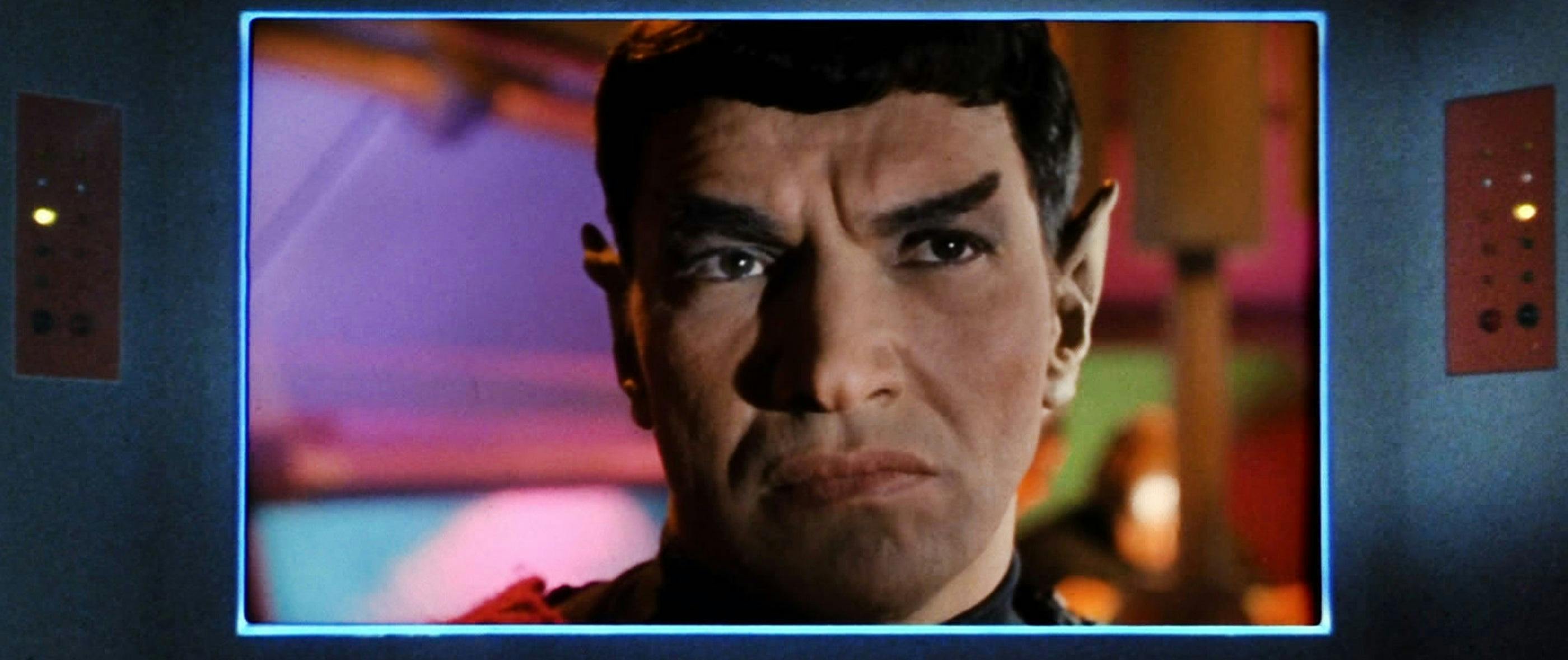
StarTrek.com
Widely considered one of the best Star Trek: The Original Series episodes, " Balance of Terror " debuted on December 15, 1966 -- or 50 years ago today. The hour gave fans their first looks at the Romulans and also at Mark Lenard, who played the formidable Romulan Commander. As you soak in the fact that it's the 50th anniversary of "Balance of Terror," consider these facts, figures and anecdotes...
- "Balance of Terror" was the 14th episode of season one.
- Writer Paul Schneider successfully evoked war stories and submarine dramas, a la the film The Enemy Below , in his teleplay. As the Star Trek Compendium puts it, think of the Enterprise as a "surface vessel" and the invisible Romulan ship as a "submarine" and you've got the basic concept.
- Schneider also wrote the TOS episode " The Squire of Gothos " and The Animated Series episode "The Terratin Incident." He passed away in 2008 at the age of 85.
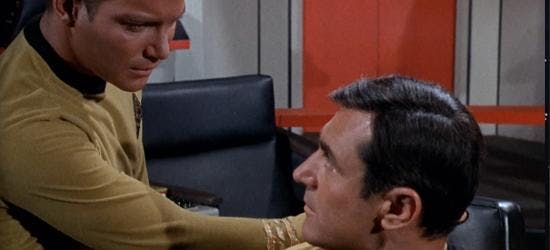
- Memorable line #1: "Leave any bigotry in your quarters. There's no room for it on the Bridge," said by Kirk to a doubting Stiles in defense of Spock and his loyalties.
- Lenard played the Romulan Commander in this Vincent McEveety-directed installment, and returned to Trek later on to play Spock's father, Sarek, in TOS , The Next Generation and several of the TOS features. He also played a Klingon captain in The Motion Picture . Lenard passed away in 1996 at the age of 72.
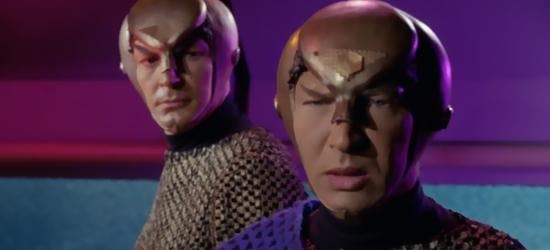
- Lawrence Montaigne, who plays Decius here, later portrayed the Vulcan Stonn in the TOS episode " Amok Time ." Montaigne, now 85 years old, has written books and remains a popular guest at Star Trek conventions.
- Memorable line #2: "Your and I are of a kind," the Romulan commander told Kirk. "In a different reality I could have called you friend."
- According to Memory Alpha , "A shot filmed, but cut from the finished episode shows Kirk saluting the Romulan commander before he destroyed his ship."
- Yes, your eyes are not deceiving you. Phasers are fired and referenced in "Balance of Terror," but the special effect you see on screen is that of photon torpedoes launching.
- According to Memory Alpha , "In the James Blish adaptation of this story, presumably based on an earlier draft of the script, Stiles dies. In addition, Robert Tomlinson and Angela Martine actually marry, in a second ceremony late in the story. When the Enterprise fires on the Romulan ship for the final time, the latter explodes immediately, with the conversation between Kirk and the Romulan commander being omitted."
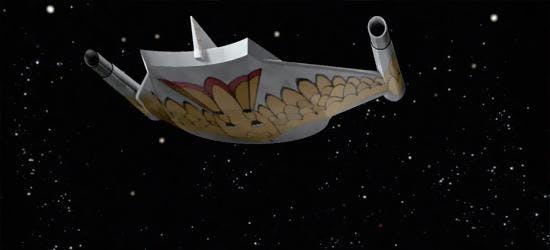
- Wah Chang designed and built the Romulan warship, but didn't receive on-screen credit for his work. Actually, he never earned a credit for his Trek efforts.

Get Updates By Email
“Balance of Terror”: Star Trek, History, and National Security
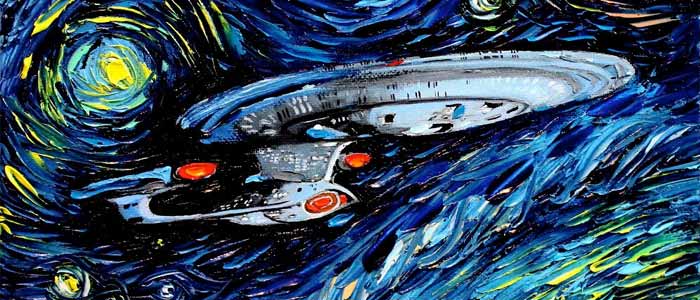
“Balance of Terror,” first broadcast on December 15th, 1966—and now celebrating its 50th anniversary—has long been seen as a classic episode of the original Star Trek . It involves a series of space battles between the Enterprise and a Romulan Bird-of-Prey around the Neutral Zone, the restricted region of space separating the Federation and the Romulan Empire. The Neutral Zone evokes the Korean Demilitarized Zone, the Iron Curtain, and the 17th parallel separating North and South Vietnam, which was a war zone when the episode aired.
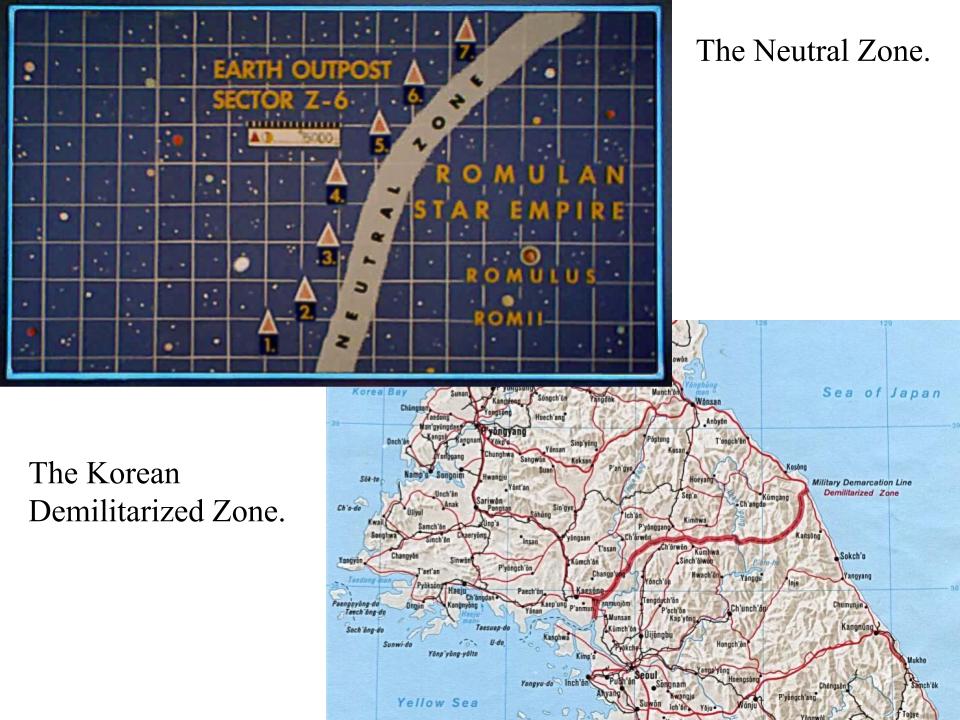
Both Captain Kirk (William Shatner) and the Romulan Commander (Mark Lenard) know that their clash could ignite a devastating full-scale war, paralleling the threat of nuclear war at the time between the United States and the Soviet Union. Meanwhile, on the bridge, Lieutenant Stiles (Paul Comi) questions the loyalty of Spock (Leonard Nimoy) because he looks like a Romulan.
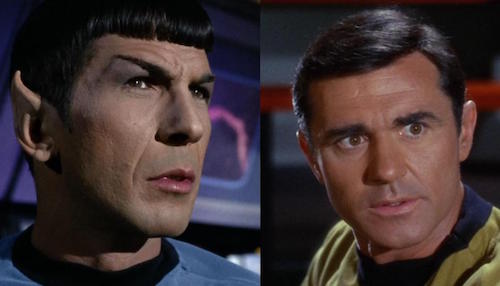
It has been little noticed that the title of the episode, “Balance of Terror,” is an exact quote from then-Secretary of Defense Robert McNamara’s description of the Cold War, with its potential for Mutually Assured Destruction . Star Trek has sometimes been criticized as a near-utopia where greed and discrimination have mostly been overcome, but “Balance of Terror” has a militaristic edge, and reveals that bigotry on the bridge is almost as much of a threat as the Romulans.
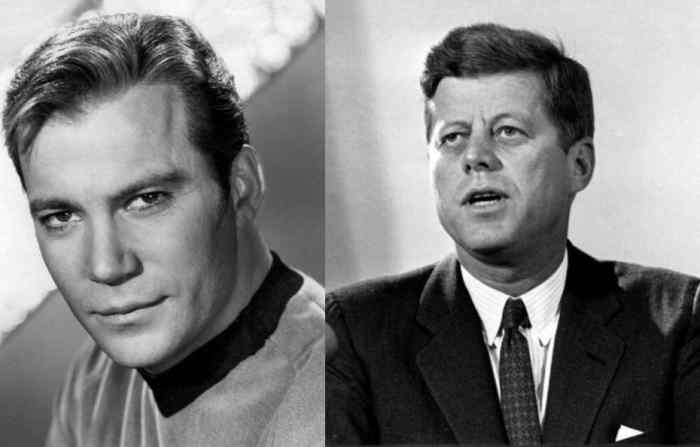
President John F. Kennedy’s handling of the Cuban Missile Crisis in 1962 is a key event to start with in understanding the historical context of this episode. From Star Trek’ s beginning it seemed that the character of Captain Kirk was inspired in part by President Kennedy (Gross, p.34), and JFK’s “ New Frontier ” was a template for Star Trek ’s “Final Frontier.” Star Trek was progressive Cold War liberalism projected into the future. And arguably Kennedy’s most important achievement was avoiding nuclear war after the Soviet Union installed scores of nuclear missiles in Cuba. As Kennedy said in a televised address to the nation on October 22nd, 1962 :
This Government, as promised, has maintained the closest surveillance of the Soviet military buildup on the island of Cuba. Within the past week, unmistakable evidence has established the fact that a series of offensive missile sites [are] now in preparation….The purpose of these bases can be none other than to provide a nuclear strike capability against the Western Hemisphere.
Kennedy went on to call the missiles a “clear and present danger” to the United States, adding that “The 1930s taught us a clear lesson: aggressive conduct, if allowed to go unchecked and unchallenged, ultimately leads to war….It shall be the policy of this nation to regard any nuclear missile launched from Cuba against any nation in the Western Hemisphere as an attack by the Soviet Union on the United States, requiring a full retaliatory response.”
A nuclear holocaust threatened the world. The US blockaded Cuba, and demanded that the missiles be removed. Kennedy did not mention that the US had nuclear missiles in Turkey at the time, about as close to the USSR as Cuba’s were to the United States. Nevertheless, the secret Soviet installation of nuclear missiles in Cuba—after Soviet assurances to the contrary—was a destabilizing move that plunged the world into crisis. Behind the scenes, most of the US military recommended to Kennedy a massive bombing of Cuba, followed by an invasion. But, as Michael Dobbs writes in his book on the Cuban Missile Crisis, “the Soviet nuclear arsenal on Cuba far exceeded the worst nightmares of anyone in Washington” (p.58). JFK resisted the military’s plans, fearing that an invasion might ignite a nuclear war. And many nuclear weapons in Cuba were, in fact, already operational. In other words, if the US had invaded Cuba this likely would have escalated into a full-scale nuclear war with the Soviet Union, with thousands of nuclear weapons deployed by each side against the other, and hundreds of millions dead.
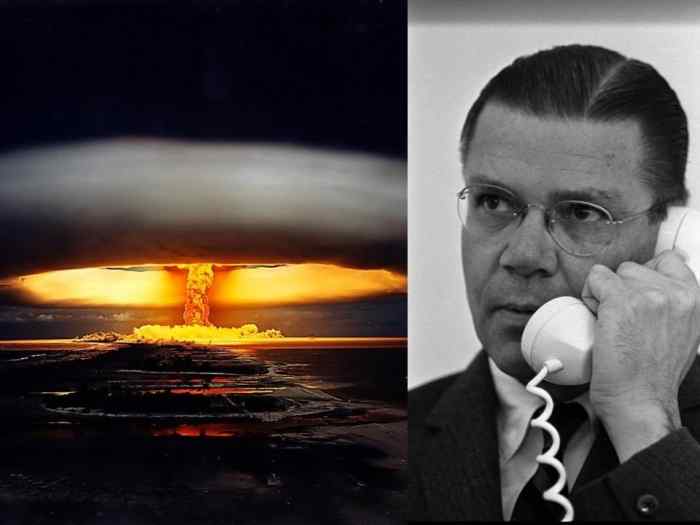
As Kennedy’s Defense Secretary Robert McNamara later wrote of the crisis: “I walked out of the president’s Oval Office, and…I thought I might never live to see another Saturday night” (Dobbs, p.311). McNamara added in an interview with the Saturday Evening Post , published in December of 1962, that the whole world was in a “balance of terror.”
The crisis was finally resolved because Kennedy offered to secretly remove US missiles in Turkey after the Soviets removed theirs from Cuba. Why was Kennedy effective at resolving the crisis? In part because he had recently read Barbara Tuchman’s bestselling book about World War I, The Guns of August . The thesis of The Guns of August is that miscalculation and misunderstanding can lead to a devastating world war that kills millions. Kennedy was so impressed with the book that he had his aides read it, and ordered copies of The Guns of August distributed to every US military base in the world (Dobbs, p.226). This book is possibly why we are all alive today—a compelling example of a historian changing the course of history.

The Cuban Missile Crisis was a shock to the United States, and one that for some evoked the surprise attack on Pearl Harbor. “Balance of Terror” was broadcast a week after the 25th anniversary of that attack, and there was a lot of media attention given to this anniversary. “Balance of Terror” similarly begins with a surprise attack on the Federation surveillance outposts that line the Neutral Zone. As Kirk is about to perform a wedding ceremony in the ship’s chapel, Ensign Sulu (George Takei) interrupts with a ship-wide announcement: “Alert! Captain to the Bridge. All decks alert.”
On the bridge, Uhura (Nichelle Nichols) reports to Kirk that Outpost four is under attack. Kirk then asks Spock to show all decks a chart showing the Neutral Zone and the Earth outposts—three of which have already been destroyed—as well as the position of the Enterprise as it moves in at maximum warp. Kirk announces to the ship that “In our next action, we can risk neither miscalculation nor error,” and then turns the briefing over to Spock, who says:
Referring to the map on your screens you will note beyond the moving position of our vessel, a line of Earth outpost stations. Constructed on asteroids, they monitor the Neutral Zone established by treaty after the Earth-Romulan conflict a century ago. As you may recall from your histories, this conflict was fought…with primitive atomic weapons. Earth believes the Romulans to be warlike, cruel, treacherous. And only the Romulans know what they think of Earth.
Even the name “Romulans” evokes the Russians during the Cold War. But the name also, of course, references the Roman Empire, especially since the names of two of their key planets, Romulus (their capital) and Remus, come from the mythological founding brothers of Rome. Although the situation is different from the Cuban Missile Crisis, Kirk, like Kennedy, is a rational leader who seeks to prevent a larger war. But Lt. Stiles, at the helm next to Sulu, recommends immediate attack:
STILES: We know Outpost four has been attacked, sir, so if we intercept the Romulans now— KIRK: After a whole century, what will a Romulan ship look like, Mister Stiles? I doubt they’ll radio and identify themselves. STILES: You’ll know, sir. They’re painted like a giant bird-of-prey. KIRK: I had no idea that history was your specialty. STILES: Family history. There was a Captain Stiles was in the space service then. Two Commanders and several junior officers. All lost in that war, sir. KIRK: Their war, Mister Stiles. Not yours. Don’t forget it.
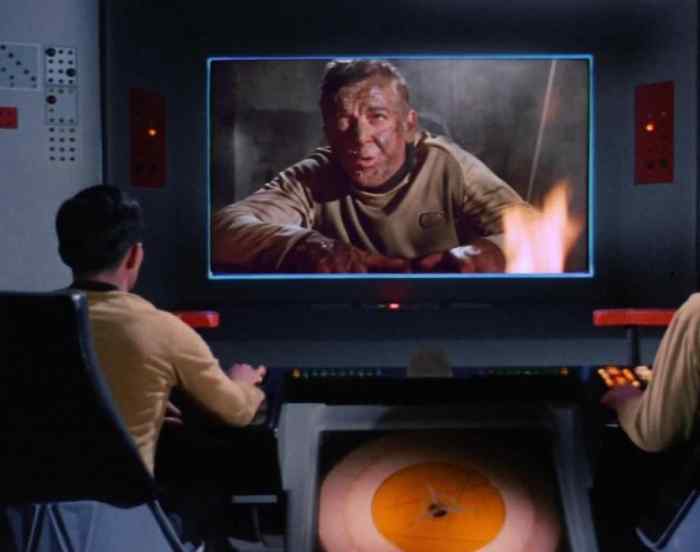
We then hear from Outpost Four, where Commander Hanson is the sole survivor of the Romulan attack. And he reports that after the attack “the whole vessel disappeared.” Suddenly, the Bird-of-Prey reappears and destroys the remains of Outpost Four, killing Hanson before vanishing again with its cloaking device.
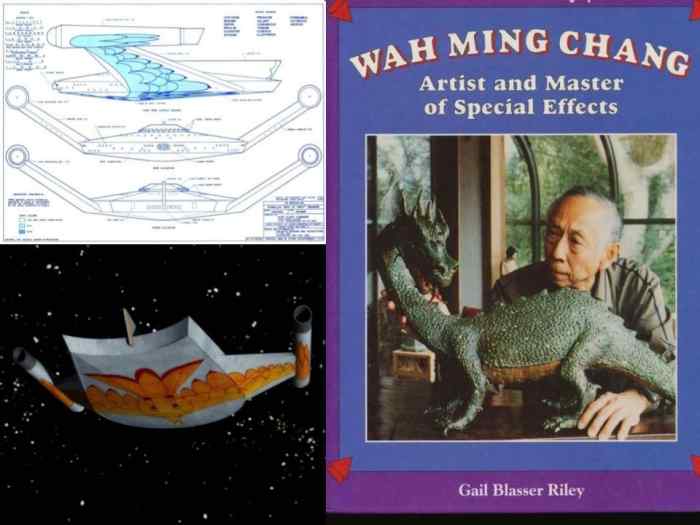
The elegant Romulan ship was created by Chinese-American designer Wah Ming Chang, who also designed the tricorder, the first-generation laser pistol, and the communicator, which was the inspiration for the flip phone of the 1990s. Chang also designed the appearances of many alien species seen in Star Trek , including the Talosians, the Salt Vampire, Blalock, the Gorn, and even the Tribbles. For the Bird-of-Prey emblem, he drew upon the symbol of the predatory eagle, used by the Roman Empire, Napoleon Bonaparte, and the Nazis.
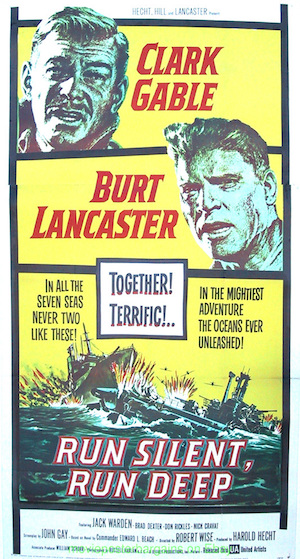
The Romulan cloaking device anticipates the “stealth technology” of Air Force bombers and fighters of a few decades later, but it also reaches back to the “silent running” mode of submarines starting in World War II. One of the movies that influenced Paul Schneider, the author of the “Balance of Terror” teleplay, was Run Silent, Run Deep , a 1958 submarine film starring Clark Gable that was directed by Robert Wise (who later directed Star Trek: The Motion Picture) . In Run Silent, Run Deep , Gable plays a submarine captain who seems almost Ahab-like in his obsessive quest for a Japanese ship that he eventually destroys.
This is similar to Kirk’s relentless pursuit of the Romulan Bird-of-Prey in “Balance of Terror.” But unlike in many military movies, which feature leaders who seem to command almost solo, from Gable, to Robert Mitchum in The Enemy Below (1957), to Gene Hackman in the 1995 sub movie Crimson Tide , Kirk has a more group-oriented mode of command in “Balance of Terror.”
Like Kennedy with his Executive Committee, or ExCom, during the Cuban Missile Crisis, Kirk consults extensively with his crew around a briefing table to analyze the situation and get recommendations. This is a model of rational, knowledge-based decision making, as opposed to a gut-based, shoot-first and figure-it-out later approach. Seated around a table, Spock holds a fragment of metal retrieved from the wreckage of Outpost Four:
SPOCK: This is the hardest substance known to our science. [He crushes it with his hand] SPOCK: Lab theorizes an enveloping energy plasma forcing an implosion. KIRK: Comments? SPOCK: Obviously, their weaponry is superior to ours, and they have a practical invisibility screen. MCCOY: You’re discussing tactics. Do you realise what this really comes down to? Millions and millions of lives hanging on what this vessel does. SPOCK: Or on what this vessel fails to do, Doctor.
Going around the table Kirk learns from Engineer Scotty (James Doohan) that the Enterprise has superior engines and is faster than the Bird-of-Prey. Stiles again recommends immediate attack, but Sulu replies, “Attack without a visible target? How do we aim our phasers?”
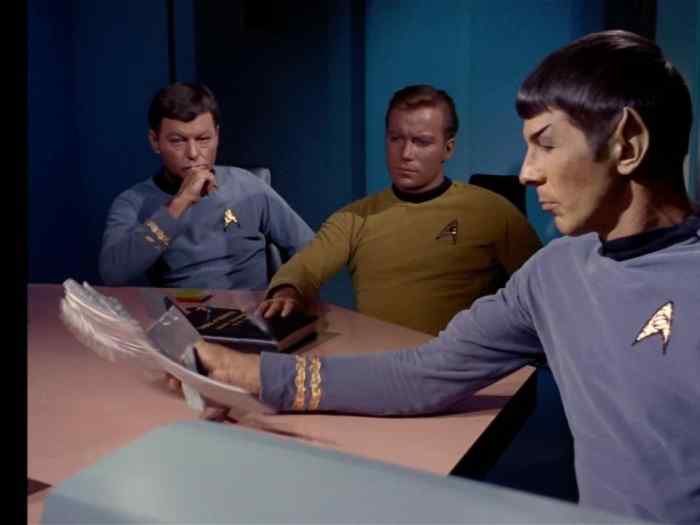
But Stiles insists, echoing the words of Kennedy and other Cold Warriors: “These are Romulans! You run away from them and you guarantee war …. You know that, Mister Science Officer. You’re the expert on these people, but you’ve always left out that one point. Why? I’m very interested in why.”
Stiles has questioned Spock’s loyalty since earlier when the Enterprise intercepted a Romulan message, revealing that Romulans look just like Vulcans. Kirk asks Uhura to decode the remainder of the message, and Stiles makes a snide remark:
STILES: Give it to Spock. KIRK: I didn’t quite get that, Mister Stiles. STILES: Nothing, sir. KIRK: Repeat it. STILES: I was suggesting that Mister Spock could probably translate it for you, sir. KIRK: I assume you’re complimenting Mister Spock on his ability to decode. STILES: I’m not sure, sir. KIRK: Well, here’s one thing you can be sure of, Mister. Leave any bigotry in your quarters. There’s no room for it on the Bridge. Do I make myself clear?
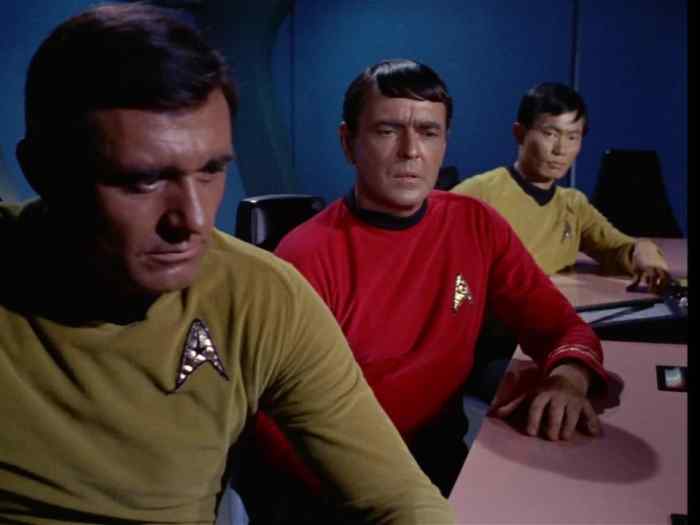
This stand by Kirk against bigotry parallels the improved Civil Rights records of some liberals during the 1960s. Presidents Kennedy and Lyndon Johnson, pressured by the Civil Rights movement and popular opinion, supported civil rights in part because it was the right thing to do, but also because America’s entrenched and government-supported racism was accurately perceived by these presidents as damaging to America’s image during the Cold War (Reeves, p. 480-510). Pictures and news films, for instance, of people being attacked by police, dogs, and fire hoses during peaceful civil rights protests in the 1960s shocked most Americans and much of the world.
Over the years, some have understandably criticized the “tokenism” of Star Trek , but in 1966 the diversity found on the bridge, with Spock, Sulu, and Lieutenant Uhura was at the time progressive. To put it in perspective, this 50-year old episode has more diversity than the main cast of Friends from the 1990s, or Game of Thrones today. And yet Kirk acknowledges that even with the progress that’s been made in the 23rd century that bigotry, like that shown by Stiles, is not unknown, and in fact may not be eliminated—only kept off the bridge. This is disturbing, but it’s perhaps realistic that even in Star Trek’s future more work needs to be done to overcome prejudice.
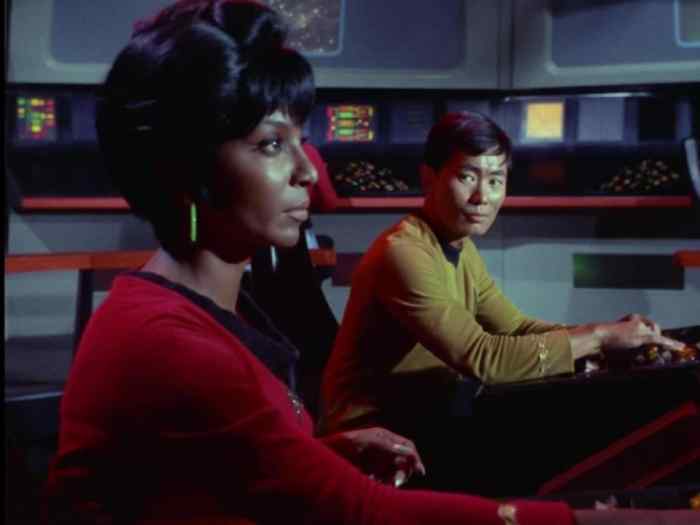
And ironically, at least from our perspective, back on the bridge Sulu agrees with Stiles that added security steps should be taken in case there are Romulan spies on board the Enterprise. The irony is that after Pearl Harbor more than one-hundred thousand Japanese Americans were forcibly removed to concentration camps for years because of racist war hysteria, a grievous trampling on the US Constitution. And George Takei, as a young boy, was, with his family, among those imprisoned in the camps. This tragic mistake, which was even approved by the Supreme Court in 1944, is one that the US is still coming to terms with, and something that Takei has personally helped raise awareness about. The bottom line, however, is that “Balance of Terror” is critiquing this kind of racial suspicion of people during wartime.
Back in the briefing room, Spock shocks everyone by agreeing with Stiles that they must respond immediately to the Romulan aggression, no matter what the cost. Spock recommends this based on his own Vulcan history, saying, “If the Romulans are an offshoot of my Vulcan blood, and I think this is likely, then attack becomes even more imperative.”
“War is never imperative!” Bones interrupts, raising the tension between them in a way that became a hallmark of the series. “It is for them, Doctor,” Spock explains. “Vulcan, like Earth, had its aggressive, colonizing period. Savage, even by Earth standards. And if the Romulans retain this martial philosophy, then weakness is something we dare not show.”
This existential concern about showing “weakness” was a backbone of the Cold War, and a main driver for the Vietnam War, which at the time of this episode was nearing its peak. The core idea held by almost everyone in the US national security establishment, including Secretary McNamara—who, as mentioned, inadvertently gave this episode its title—was that Vietnam was like a domino piece, stacked up in a row next to all the other domino pieces of the various countries of Asia—so that if one fell to Communism, they would all fall.
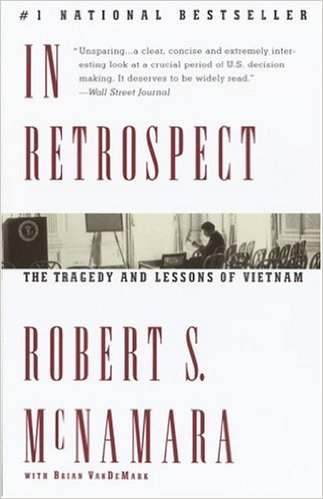
Thirty years after this episode was broadcast, McNamara published his memoirs, and even wept on national TV, for his crucial involvement in what he concluded, as his title said, In Retrospect , was a war that was a colossal mistake, based on a misunderstanding of Vietnam, in part because of the fatally-flawed “domino theory.”
Even in 1966, Star Trek’ s references to the Cold War were seen by many. For instance, TV Guide highlighted this episode in that week’s issue with a special “Close-Up,” stating in its short review that “the warlike Romulans have sent a powerful flagship to probe earth’s defenses. Kirk knows that retreat will only invite further devastation. His alternative: counterattack” (Cushman, p. 233)
Vietnam was the first television war, and news programs like the CBS Evening News with Walter Cronkite, which brought the war into millions of American households, aired right before Star Trek ’s 7:30 start time in major markets. As Marc Cushman writes, in 1966, “The troops of North Vietnam continued to pour across the DMZ into the South, carrying out their military strikes, testing American defenses, and then retreating to the safety of home. The actions of the Romulans in ‘Balance of Terror’ were clearly designed to mimic the tactics of the Viet Cong of this era” (Cushman, p.234).
This episode of Star Trek , in other words, can be seen as a cultural part of the Cold War. It might even be seen—with its fetishized phasers—as providing support for the military-industrial complex that President Dwight D. Eisenhower warned the nation about in his farewell address in 1961.
That’s part of it. But “Balance of Terror” is more complicated than that. As the cat-and-mouse battles between the Enterprise and the Bird-of-Prey unfold, with both vessels being heavily damaged—and the Enterprise almost destroyed by a Romulan nuclear weapon—we see that the Romulan commander is not a stereotyped and vicious enemy, but instead a sympathetic character.
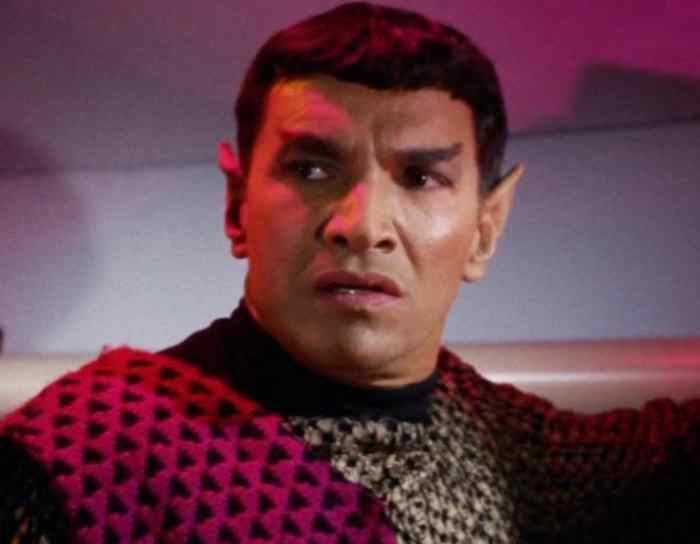
We see the unnamed Romulan commander on his bridge, which, in homage to the submarine movies from which this episode borrows, looks like the bridge of a futuristic submarine, with viewing controls hanging from the center of the ceiling like a periscope. Like Kirk, the Romulan commander knows that the decisions he makes could mean death for millions if a larger war is triggered. The moody lighting, including strange pink hues for the Romulan commander, and shadowy key lighting for Kirk, shows the weight of their decisions literally playing across their faces (McDonough). The Romulan commander says to his second-in-command and friend, with whom he’s served for many years:
No need to tell you what happens when we reach home with proof of the Earthmen’s weakness. And we will have proof. The Earth commander will follow. He must. When he attacks, we will destroy him. Our gift to the homeland, another war….Obedience. Duty. Death and more death….I find myself wishing for destruction before we can return.
Meanwhile on the Enterprise, in a moment of down time in his quarters, Kirk confesses his doubts to Bones. Kirk knows that Bones has been the strongest critic of the pursuit of the Bird-of-Prey, and so Kirk is dropping his Captain’s mask and making himself vulnerable—which reveals the depth of their friendship.
KIRK: I look around that Bridge, and I see the men waiting for me to make the next move. And Bones, what if I’m wrong? MCCOY: Captain, I— KIRK: No, I don’t really expect an answer. MCCOY: But I’ve got one. Something I seldom say to a customer, Jim. In this galaxy, there’s a mathematical probability of three million Earth-type planets. And in all of the universe, three million million galaxies like this. And in all of that, and perhaps more, only one of each of us. Don’t destroy the one named Kirk.
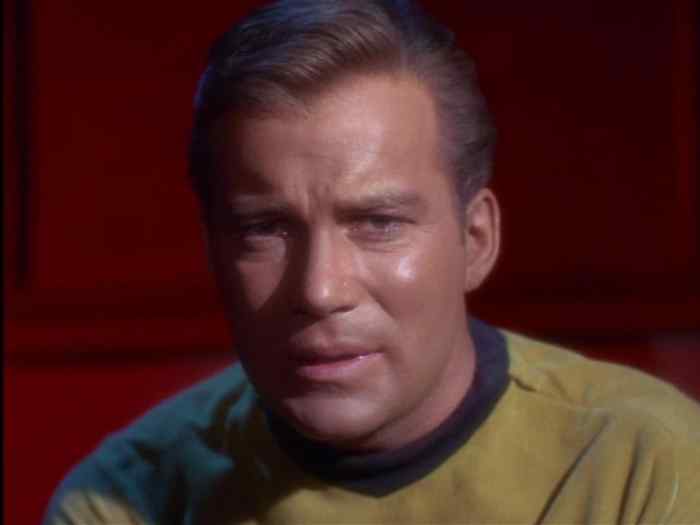
The sympathetic portrayal of both sides locked in this death struggle is almost as much of a critique of the Cold War as it is a reinforcement of it. And Bones, sounding almost like Carl Sagan , infuses this part of the episode with a cosmic and yet empathetic perspective on this cold war in space.
But the costs of war are nonetheless made clear. An all-out war is avoided, just barely, but with the loss of many lives. And as the Romulan commander says to Kirk at the end, “You and I are of a kind. In a different reality, I could have called you friend.”
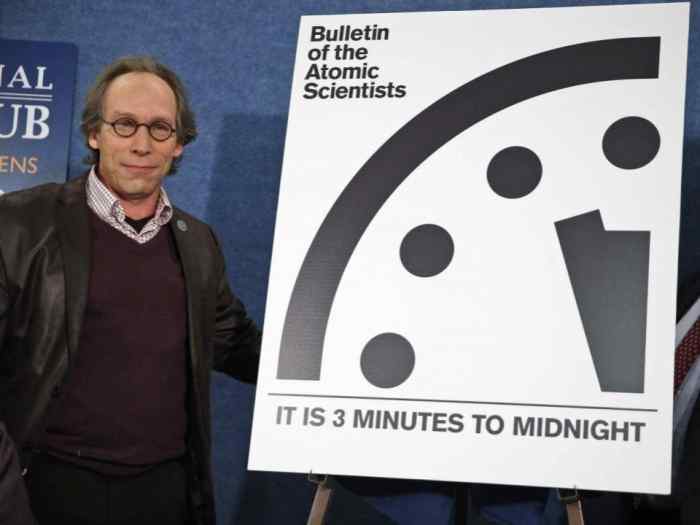
But conflicts of this kind don’t have easy solutions, as we still know today. Since the dawn of the nuclear age, the Bulletin of the Atomic Scientists has published a Doomsday Clock . In 1966, it was set at five minutes to midnight. And today, fifty years later, with much fluctuation of the minute hand in the intervening decades, the clock stands at three minutes to midnight. It is bittersweet to say that this episode is still relevant, because it means that we are all still living in a balance of terror.
Works Cited
Stewart Alsop, “McNamara Thinks About the Unthinkable,” Saturday Evening Post , December 1, 1962, p. 18.
March Cushman with Susan Osborn, These Are The Voyages: TOS Season One , Expanded and Revised Edition, Jacobs/Brown Press, 2013.
Michael Dobbs, One Minute to Midnight: Kennedy, Khrushchev, and Castro on the Brink of Nuclear War , Knopf, 2007.
Edward Gross and Mark A. Altman, The Fifty Year Mission: The First 25 Years , St. Martin’s Press, 2016.
Megan McDonough, Star Trek’s “Balance of Terror”: Shedding Light on a Big Decision , unpublished review.
Robert McNamara with Brian VanDeMark, In Retrospect: The Tragedy and Lessons of Vietnam , Crown, 1995.
Richard Reeves, President Kennedy: Profile of Power , Simon and Schuster, 1993.
Gail Blasser Riley, Wah Ming Chang: Artists and Master of Special Effects , Enslow Publishers, 1995.
Barbara W. Tuchman, The Guns of August , Macmillan, 1962.
What do you think? Leave a comment .
Want to write about TV or other art forms?
Receive our weekly newsletter:
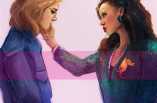
52 Comments
For all the obvious parallels to the Japanese, there is a stronger parallel to China. At the time this episode aired, communist China was a completely closed book to the West. This was still 6 years before Nixon went to China and established relations. That’s also why Romulans and Klingons get their stuff from the same place: like the Russians supplying China, the Klingons sell ships to the Romulans.
If anyone want to stream the episode, it is available for free on archive: https://archive.org/details/Star.Trek.TOS.1×14
I hear this episode is a major inspiration to the upcoming Star Trek Discovery series. Hear hear!
I remember when I had watched this episode for the first time, and liked it a lot, I told a friend about it. It turned out she was appalled, especially by the line “In a different reality, I could have called you friend” (which I had found very touching). She considered it trite, clichéd, and war-glorifying, part of a highly questionable soldier ethics.
This is a fine example of what science fiction should be. Meaningful episode with great references.
Brilliant, Ben. Great reading. It’s episodes like this that I use to illustrate to people how great ST:TOS was — the bold and intelligent scripts, the depth of subtlety to the stories. Season One stories particularly borrowed from Shakespeare, recent history, and even headlines, to provide topical entertainment in the guise of outer space adventure.
I think the episode owes much to Dick Powell’s 1957 film THE ENEMY BELOW (from the great Denys Rayner’s novel) with Robert Mitchum and Curt Jürgens, particularly the two captains gaining respect for each other, and one’s disenchantment with his own military organization. Duty, loyalty, frustration with loss and destruction,… many of the elements of the TOS episode are there in the WW II film. (I’ll admit I have to see RUN SILENT… again, been a long time.) The end of ENEMY BELOW always gets me choked up. Despite their adversarial conflict, the American captain helps his “enemy” to rescue the latter’s dying friend from the sinking U-boat.
Note that this episode, was well as others, is available for streaming on Netflix and other services. And of course, on home video Blu-ray disc.
Thanks, everyone, for your comments. As David writes, The Enemy Below was yet another influence on this episode. And, as he also says, The Enemy Below is a good World War II sub movie that’s worth seeking out. For me, “Balance of Terror” is in my top ten in terms of episodes of the original Star Trek—I’m just not sure what the other nine are right now….
I love Balance of Terror, here’s my slightly arbitrary Best of Original Trek list:
1. Amok Time 2. City on the Edge of Forever 3. Balance of Terror (yay!) 4. The Trouble with Tribbles 5. The Doomsday Machine 6. Friday’s Child 7. Where No Man Has Gone Before 8. Journey t Babel 9. The Naked Time 10. Requiem for Methusalah
Sike—that’s a great list. Mine list is similar, although it changes each time I try to make one lol! Anyway, my top three are the same as yours: 1. Amok Time 2. City on the Edge of Forever 3. Balance of Terror 4. The Doomsday Machine 5. The Enterprise Incident 6. The Tholian Web 7. Mirror, Mirror 8. The Menagerie 9. What Are Little Girls Made Of? 10. Arena
and I’m still leave a lot of favorites out.
My Top Original Star Trek Top 10:
1. City on the Edge of Forever 2. Amok Time 3. The Menagerie (two-parts) 4. Balance of Terror 5. Errand of Mercy 6. The Devil in the Dark 7. This Side of Paradise 8. The Corbomite Maneuver 9. Mirror Mirror 10. Journey to Babel.
I am a big fan of ST:TNG, ST:DSN and ST:Voyager as well, but at 62 years old now, my fond recollections of growing up with the original series remain supreme for me.
Stupendous review of “Balance of Terror,” which is one of the show’s finest episodes. The way suspense is built in the completely is a model of its kind. You brilliantly incorporate Cold War posturings, racial prejudice and the real threat of nuclear obliteration, which of course was as you note part of the BoT screenplay. I was amazed to learn that McNamara’s quote parallels the episode’s title. Just remarkable how this episode mirrored the politics of the time, the Bay of Pigs and other aspects of the Kennedy administration. Magisterial piece here!
As entertaining as the original Star Trek series is… there is no doubt that The Next Generation series is the golden age of Star Trek.
skag: I love TNG as well, but even though they are both Trek for me it’s almost like comparing apples and oranges. For instance, the music which is so dramatic, memorable, and over-the-top on TOS becomes in TNG an often-bland wallpaper background. Picard and Kirk are obviously a study in contrasts in terms of age, looks, nationality, approach, etc. But both are equally great captains imho. There are more “good” episodes of TNG, but that’s largely because it lasted 7 years instead of the 3 that TOS got, etc. But then again I also love the best of DS9 and Voyager just as much.
In any case, there are definitely several episodes of TNG that might be worthy of the kind of in-depth exploration that I attempted here. Maybe you or someone else will be the one to write an article of your favorite TNG episodes?
I watched TNG as I moved from my teens to my twenties. The first two series were really bad I thought, embarrassing at times. But after the Season 3/4 cliff-hanger, it became brilliant. Some episodes were duffers alright, but the dynamic between all the characters, especially Data’s ongoing quest to be human, was great to watch. Again, it was one of those series where the characters transcended the environment they habited.
I especially liked Worf when he would pull the “if I was not in Star Fleet I would kill you routine”. He did it all the time, he threatened every other male on the show at some point, hiding behind Star Fleet rules.
And as the show went on it subverted itself, mixed things up and became a classic bit of telly.
Even so, I got bored by it when they visited yet another planet where the entire population lived in a village with a little fountain in the middle, and no one had cars.
Doubt! DOUBT!
If you follow comic book terminology, you could possibly call TNG the Silver Age, but not the Golden Age: you should save that for the original flowering.
Balance of Terror is my favorite episode because there is a real humanity to it. I love the wedding opening because it is a glimpse of every day life on a star ship and it connects us in the present to the future. I love the not-fully-explained conflict on the Romulan ship which conveys that everyone has their own story, even if we don’t see it. And the commander’s last line gets me every time…
Balance of Terror is on many points a gripping episode if you ignore: A) the films its based on and B) the highly problematic ideological underpinnings.
The film doesn’t just transfer submarine war movie elements to a Sci-Fi story regardless if they fit or don’t. And they don’t fit at all, neither the firing of the phaser like depth charges nor the plasma weapon which is some kind of torpedo, but for no clear reason the Enterprise can’t simply step out of its course. And certainly not the whispering on the silent ships. The major problem is the episode essentially remakes situations and stories especially from The Enemy Below and lifts character constellations directly. The Romulan commander, his centurion and the careless nationalist fanatic are clearly a copy from this film.
What’s arguably worse is that the Enemy Below was essentially a film to reintegrate post war Western Germany into the western defence system and to encourage their building of an army. The idea was to show the Wehrmacht as honourable fighters while the evil ones were the SS and other Nazi organisations. So the soldiers which stood on both sides can join together now to fight a new enemy, the Soviets. However this manouvre sweeps the Wehrmacht war crimes under the rug by emphasizing soldier’s duty which was exactly the defense of all Nazis and German soldiers regardless of any crimes they did commit. So the episode’s positive and complex drawing of the Romulan commander has a rather dubious underpinning.
Michel: You make some great points here about both The Enemy Below as well as this episode. One thing to consider, however, is that a TV show has a lot of limitations in terms of what they can show and the shorthand they sometimes need to employ. For instance, as you know, on one level it might be silly that the Romulans aren’t speaking Romulan—although we could potentially say that the Universal Translator is working really well! But, on the other hand, the “foreigners speaking English” thing is used on so, so many programs, many of which are excellent. To give just one example, everyone in the BBC program “I, Claudius” from the 1970s speaks with a British accent rather than Latin with subtitles. Anyway, in terms of your bigger point of the problematic morals involved, I think you illuminate some important issues. I still think for a TV program from 1966 it’s thought-provoking, as well as dramatic, and has also stood the test of time pretty well.
My favorite episode from the original series: first seen when I was 8 or 9 years old, lo these many years ago. It’s stood the test of time.
Some of the genius of the episode is the way the struggle is presented as a contest between two very smart commanders who gain deep respect for the other, supported by good and bad advice from their crew. Arguably what dooms the Romulan is the loss of wise counsel from the Centurion: you could write an alternate story in which Spock’s loss leads to a fatal mistake by Kirk.
Great piece! You might want to take a look at Glen Cook’s novel, “Passage at Arms” which is also a submarine vs. destroyer in space story.
I think Balance of Terror was really on to a fundamental rule of good writing: if you want your fictional battles to be exciting, make them asymmetrical.
After reading this article, I watched this episode again after many years, and was glued to the edge of my chair even though I knew what was going to happen. Thank you for this.
The episode was almost directly lifted from The Enemy Below; watch the back to back and you can almost make a drinking game out of the similarities.
The Romulans were a stand-in for communist China. Like the Romulan Empire, it was fairly isolated at the time. (A bit like North Korea today.) China only opened up after Nixon normalized relations in 1972, thus inspiring an old Vulcan saying. Also, a lot of that distrust of Spock may reflect back to WWII more than the Cold War, since this episode was also a deliberate remake of a couple of WWII submarine movies.
But the Romulans were always much more interesting adversaries, though also more difficult to work into a script. That’s probably why the TNG writers worked so hard to make the Klingons deeper and more interesting.
Balance of Terror was the first episode of the original series I saw, on VHS in the early 90s. A good starter. And really overall an excellent work of television.
I always found Diane Duanes Romulans much more intresting than how they were portrayed in STNG.
Just rewatched this last week, the new SFX were very CGI but just as enjoyable as the old. I think that Star Trek was pretty incredible for touching on social issues and being very entertaining. Thank you for writing About the original episodes, I look forward to writing from you.
I love this episode. I have grown up knowing what romulans “look” like but I wonder what it would have been like to be sitting in front of the TV in 1966 and be surprized by how the romulans looked like Spock… must have been very cool
Romulan Wars!
Not sure if this is going to be of interest to anyone, but I’ve been reading the Star Trek novels describing the Romulan War, and they do a really nice job of explaining why the humans and their allies never actually see the Romulans. Basically, some higher ups in Starfleet and on Vulcan DO know that the Romulans are a Vulcan splinter race, but the information is confidential so as to avoid creating a schism between Vulcan and the other worlds that will eventually form the Federation. Also, the Romulans wear helmets when engaging in close combat (where they always win, meaning the humans don’t get a chance to examine their bodies) or simply nuke the enemy from orbit.
An excellent write-up for an excellent, memorable and enduring episode!
This cogent article connects the dots between art, history and geopolitics in the mid-20th century. Ben Hufbauer’s analysis is not only thoughtful and perceptive but an important wakeup call for all Americans. I hope teachers and college professors will assign this elegantly constructed essay in their classes. It is a model of excellent writing — economy with depth, an accessible and reader-friendly narrative with flare, and a thesis that boldly goes where few others have gone before!
The Romulans were always my favourite of the Trek ‘villains’ Some of the episodes featuring them in The Next Generation were absolutely superb.
It is basically a remake of the 1957 Movie “The Enemy Below.”
In the original series, Romulans were ancient Romans and Klingons were Soviet Russians. Romulans had a senate and a praetor, and duty and honor, while the Klingons were a totalitarian society where every level spied on the level above and below it.
This is probably the best episode to date; indeed one of the best episodes in the entire series.
It manages to make its social commentary without being overly preachy.
“Balance of Terror” is one of the best episodes of Star Trek, movies included. It is certainly in the running for best episode, period. Not only does it make science fiction accessible to new viewers, by way of nostalgia, it provides an excellent point of reference to real life experiences of the audience (WWII vets) etc just like this article details.
One of the things that I like about this episode is the things we don’t see. The Romulan Commander, for instance, is tired of war. He wants to go home, etc.
TV has produced some wonderful characters and scenarios over the years. It’s time to think of these characters in the same way we think of Dracula say: we can make him for our own time.
I have always felt that BoT is really one of the best, if not the best, episode of the original run. The only thing that really bugs me is the rather convenient coolant leak in the phaser room. I don’t recall if the prior nuclear blast that damaged the ship had anything to do with the leak, because it feels rather conveniently staged for Spock to jump in and save the day.
This is one I like more every time I see it.
This is extremely well written with a very clear thesis. Great read! It makes me want to jump into the Star Trek television series.
This has always been my favorite classic Star Trek episode, with the possible exception of Galileo Seven. My father introduced me to these shows before I was ten years old, and rewatching them at twenty-one I see them with more sophistication each time. I think the fiftieth anniversary of some of these episodes is a wonderful time to look back over them, to see how far Roddenberry was able to look into the future. With the recent casting of a new actor to play Lenard’s old character of Sarek, I may be coming back to this episode soon–going back into it armed with the research and knowledge from this essay will make the experience all the more enjoyable.
As a kid, I always enjoyed the episodes with the Klingons on and the The Romulans because it was so clearly using them as models in the cold war days with fire of the Russion/Klingons and and the cool, steely-eyed Chinese /Romulans. I need to go back and watch those episodes., Thanks for the flashback/
I remember watching that episode when it aired. It made me think then, and it resonates now. Thank you for this well-considered, well-researched essay.
Van Gogh was a crazy guy, but damn he could paint magic on a canvas
In case anyone is interested, here is a video version with more illustrations….
https://www.youtube.com/watch?v=jmlqXW1ea-o&feature=youtu.be
Many television programs such as Star Trek, Charmed and True Blood have many symbolic meanings in them. We watch these television programs that have been created in the under the veil of fiction but instead of writing fiction the writers and directors are trying to decipher the world around them and what has happened, what is happening and what they perceive will happen in the world around them. In my opinion there are three main reasons that the veil of fiction has been added to these stories: 1) To get people to watch the television show in the first place, 2) So they do not offend any who may have witnessed or been involved in a similar thing and 3) So that they can add an interesting plot line around the hard cold facts.
Notice how the arts and hacks who made this show, made sure that everything otherworldly, even fearful was true to what I call Kirbyism w as meant to denote an italic or Roman echoed response, no less than calling the enemies after Romulus, which is the essence of dehumanizing, as the m of Romans or Romumen, is detached and given an almost Richard Liu Lllll, and om not really kidding that much. Even Spock is from Vulcan, a shoot off of Roman, abd how that connection was made ill never know, but alas have become so thoughtfully and decent as they skip to the orders of some federation, also a Roman word, but whose counting. Still even as a kid, I always resented this, as saw it before, how ingratful it was that the people of Vespucci had no correlation on this new Ulysses ship, but have said my connection of Ulysses and Kirk before,still…it was what bothered me so to see this crappy little show and its constance admonishment of all the nuns held sacred, and how flippant they were about how good they all were. Two years ago did a cartoon called The earth rise about an Italian red shirted cog left to die on a planet caldera Vega 5 by a ship called the Anglicize, and its bloated cast and mixed raced crew and Jewish cyclical computer man were all turning into distorted stereotypes to die to a run in with this once red shirted captain now seeking revenge, and out to save from its utopia a fellow yeoman amend Darla Fontana. I have recently gotten it published, but not from who asked for it to begin with , but a compilation who liked my adroitness at drawing wally wood space ships, and too, had to make sure that sadly, but did it as they were nice enough to let a lot get through the others wouldn’t, the imagery of a fallen uss enterprize was enshrouded a tad. But the stoary was the same, in how as a boy i stunningly rooted for Khan, as captain Kirk, like smug Ulysses and his Trojan horse was something my Roman heart couldn’t abide. The joke of yesteryear was that within ten years, the Trekkie’s were supplanted and overshadowed by a roman loving adherent of the ancients in George Lucas, and suddenly federations were supplanted by that most Roman of ideas, the empire vs the republic.
Would it not also be interesting and practical to consider this piece in the context of current military conflicts in Syria?
The author concludes with “It is bittersweet to say that this episode is still relevant, because it means that we are all still living in a balance of terror.” I think a nod to current events contextualizing the time in which the piece is/was written would provide valuable context.
An enjoyable essay to read. I’ve written on nuclear strategy and this essay provides an interesting perceptive on that topic.
Great bit of writing, loved reading the parallels between Star Trek and The Cold War.
I really enjoyed this piece and how informative it was. It is great how you have taken the historical context into account and added a new layer of meaning present-day viewers might miss.
Leave a Reply Cancel reply
Save my name, email, and website in this browser for the next time I comment.
Prove you are human, type c a t s in singular form below:

Musings of a Middle-Aged Geek
… observations from a lifetime of geekiness.
Star Trek’s classic episode,”Balance of Terror”: Not bad … for a remake
“It moves as we move…”
Back in 1980 or so, I bought a first edition copy ( the dark blue cover ) of Allan Asherman’s must-have “Star Trek Compendium,” wherein I read that “Balance of Terror,” one of my favorite episodes of the Original Series (TOS), was actually based on a 1957 World War 2 movie called “The Enemy Below.” Asherman’s book didn’t go into too many details about the episode’s similarities with the Dick Powell-directed film, but years later, in the mid-1990s ( a great time to be a Star Trek fan ), I finally caught “The Enemy Below” on cable, and I was absolutely gobsmacked at just how closely Paul Schneider’s TV script mirrored the film. “Balance of Terror,” one of the most celebrated episodes of TOS Star Trek is, in fact, an almost beat-for-beat remake.

This isn’t to detract from “Balance of Terror,” which is still a fine piece of both Star Trek and 1960s television ( the episode also served as an unofficial inspiration for much of Nicholas Meyer’s “Star Trek II: The Wrath of Khan” as well ). “Balance of Terror” introduced the Romulans and actor Mark Lenard to Star Trek–both of which became very important to the franchise in the decades ahead. The Romulans, an emotional offshoot of their logical Vulcan cousins, would play vital roles throughout the various Star Trek series & movies, particularly in the latest spinoff series, “Star Trek: Picard,” where we see the seeds of their eventual reunification with the Vulcans, a goal long achieved by Star Trek’s 32nd century ( Star Trek: Discovery, “Unification III” ).

Actor Mark Lenard (1924-1996), the nameless “Romulan Commander,” would later play Spock’s father “Sarek” in TOS’ “Journey to Babel,” as well as “Star Trek III: The Search For Spock (1984)”, “Star Trek IV: The Voyage Home” (1986), “Star Trek VI: The Undiscovered Country” (1991) , Star Trek: TNG’s “Sarek” and “Unification” Part 1. Lenard also played the ill-fated Klingon captain seen at the beginning of “Star Trek: The Motion Picture” (1979) . The character was then played by the late Ben Cross in “Star Trek” (2009) and by actor James Frain in “Star Trek Discovery.” Lenard had said in early interviews from the 1970s and early 1980s ( Starlog magazine ) that he actually preferred the role of the Romulan Commander over Sarek, because it offered him a greater acting challenge.
“The Enemy Below” was based on a 1956 British novel by Denys Rayner, but for the purposes of this column, I’m sticking with the more popular American-made movie, which naturally changed the book’s hero vessel from British to … well, you guessed it, American . The synopses of both “The Enemy Below” and “Balance of Terror” can be roughly summed up as follows:
A young ship’s captain proves himself in combat when he pursues a powerful, stealthy enemy vessel, playing a dangerous game of cat-and-mouse with her commander. The two men are nearly a tactical match, often anticipating each others’ moves. After hours spent in hot pursuit, exchanging deadly weapons’ fire and nursing their wounds, the enemy vessel is ultimately defeated, but at great cost to both sides. The commanders acknowledge their kindred natures when they finally meet.
The differences, however, lie in the details …
“Parallel course.”
Beginning with the ships, we have Star Trek’s USS Enterprise , the flagship of the Federation Starfleet ( or United Earth Space Probe Agency ). The Enterprise is a large exploratory vessel designed for long-range interstellar first contact missions, fitted with warp drive, deflectors, shields, and a full suite of scientific equipment, as well as phasers and photon torpedoes for defense. She is not technically a warship , per se, but she is classed as a Constitution -class ‘heavy cruiser.’ Her crew of 430 consider themselves explorers, but defense of Federation planets and interests is part of their mission as well. In “Balance of Terror”, the Enterprise responds to distress calls from obliterated Earth outposts along the “Neutral Zone” between the United Federation of Planets and the Romulan Star Empire–a mysterious, unseen enemy kept at bay by a radioed treaty for the past century. The distress call interrupts a wedding aboard ship between weapons specialists Lt. Robert Tomlinson (Stephen Mines) and Lt. Angela Martine (Barbara Baldavin); a ceremony officiated by Captain James T. Kirk ( William Shatner ).

“The Enemy Below” hero ship is the Buckley -class destroyer escort ship, USS Haynes , a ship patrolling the South Atlantic Ocean during the height of World War 2. The crew of the Haynes are tired, bored by long stretches of inactivity and a bit weary of their young new captain, Murrell (Robert Mitchum) who recently transferred in from the Merchant Marines; a self-acknowledged “feather merchant” who has to prove himself to this war-weary crew of new and seasoned personnel. They soon get their chance when the sonar control officer detects a blip from a German U-boat ( submarine ), on course for an important rendezvous. Capt. Murrell asks the crew to go on temporary radio silence and orders a parallel course with the enemy target, carefully pacing its every move.

Captain Murrell gets along well-enough with his “XO” (Executive Officer), Lt. Ware (David Hedison), who initially questions the captain’s decision to parallel the enemy U-boat’s course instead of immediate engagement. Kirk encounters no such resistance from his own First Officer, Mr. Spock (Leonard Nimoy, 1931-2015), though his parallel course command is questioned by his navigator, Lt. Stiles (Paul Comi). Both Kirk and Murrell intend to learn as much as they can about their respective targets before engagement–a mark of command wisdom; intelligence-gathering before any use of force.
Note: Just as actor Leonard Nimoy’s “Mr. Spock” is famously half-human and half-Vulcan, actor David Hedison (1927-2019) would gain fame a year later as the star of “The Fly” (1958), playing Canadian scientist “Dr. Andre Delambre,” who develops a crude prototype of Star Trek’s ‘transporter’ and accidentally becomes half-human/half-insect himself, after a common housefly is trapped in his machine during a trial teleportation. Hedison would also play Executive Officer “Captain Lee Crane” in Irwin Allen’s 1964-1968 TV adaptation of his 1961 feature film, “Voyage to the Bottom of the Sea”–a series sometimes compared to Gene Roddenberry’s “Star Trek.”

In both stories, the captains receive comfort and moral support from their ships’ doctors. In Kirk’s case, he has longtime friend, Dr. Leonard “Bones” McCoy (DeForest Kelley) in his corner, while Murrell has the support of his ship’s older unnamed doctor (Russell Collins), who is at his captain’s side when he’s not busy in surgery himself, amputating the fingers of a young weapons officer who accidentally gets his hand caught during rapid deployment of depth charges.
Just as Kirk acutely feels losses under his command ( Lt. Tomlinson ), the compassionate Murrell quickly goes to see the weapons officer after his traumatic surgery, giving the young sailor words of encouragement. Murrell’s scenes with his ship’s doctor are very similar to the classic scene roughly midway through “Balance of Terror,” where a doubting Kirk is visited in his quarters by McCoy. As Kirk gets ready to resume his duties, McCoy reminds him that “…in all of (the universe), and perhaps more, (there’s) only one of each of us… don’t destroy the one named Kirk.”

Both Kirk and Murrell receive pushback from a pair of malcontents under their respective commands. Kirk’s comes in the form of his racist navigator, Lt. Stiles. Stiles questions Kirk’s orders at several points in the story, particularly his decision to trust Mr. Spock, after it’s revealed the Romulans look exactly like Vulcans–a revelation made possible by Spock’s own ingenuity, after he traces a comm signal from the Romulan vessel’s interior. Kirk gets somewhat rattled by Mr. Stiles, nearly losing his cool with the navigator on the bridge. When a sotto voce Stiles accuses Spock of being a Romulan spy, Kirk angrily spins the navigator’s chair around–dressing him down in front of the entire bridge crew. Ouch! Murrell is a lot cooler with how he chooses to deal with his bigmouthed, blowhard Quartermaster (Biff Elliott), whom he shuts down much earlier on in the movie. The ship’s Quartermaster still gossips behind Murrell’s back, of course, but he never again makes the mistake of doing so in front of his captain. Point Murrell…
Note: Actor Biff Elliott, who plays the USS Haynes’ obnoxious Quartermaster, would later find himself in the Star Trek universe as Schmitter, an ill-fated pergium miner on planet Janus VI. Schmitter becomes the latest victim of “The Devil in the Dark” (1967) in that classic episode’s opening teaser. The hapless Schmitter winds up “like the rest of ’em. Burned to a crisp.” Payback’s a bitch.

In both the episode and the movie, we see the crew listening intently to public addresses by their commanding officers over their ship’s intercoms. This is a nice way of communicating tension in a scene by showing the crew visibly react to their commanding officers’ words–seeing the tension in the young mens’ faces as they nervously hear their orders. Star Trek’s more evolved crew show less visible reaction at Kirk and Spock’s words, but the crew of the Haynes wear their weary emotions a bit more on their dirty sleeves.

Note: Star Trek has long used shots of the crew listening to their various captains over intercoms. It was more commonly seen in the first season of TOS (also see: “The Corbomite Maneuver”), but only sporadically used in later seasons and spinoff Star Trek series. Most effectively, we heard Spock counting down to the Enterprise’s hostile reception at Khitomer in “Star Trek VI: The Undiscovered Country” (1991), with a panning shot of sweat-soaked, nervous young engineering crew members anticipating their ship’s thrashing at the hands of a cloaked Klingon vessel. Sometimes the old tricks work best…

In one way, “Balance of Terror” goes a step too far in paralleling “The Enemy Below” with the appearance of its never-again seen Phaser Control Room, a 23rd century analog to the Haynes ‘ more primitive torpedo room. We’d later see a torpedo room on the Enterprise as well, in “Star Trek 2: The Wrath of Khan.” The addition of the Phaser Control Room gives the Enterprise more of a World War 2-era feel, as officers manually ‘load’ phaser banks ( ?! ) before firing. This time-wasting step slows down the ship’s defenses considerably, as the episode itself demonstrates when the Phaser Control Room’s coolant leak near the end of the story kills Lt. Robert Tomlinson, and briefly leaves the Enterprise vulnerable to the Romulan vessel’s counterattack.

A quick-thinking Spock saves the day, when he hears Kirk repeatedly calling down to Stiles, who’s assisting the ill-fated Tomlinson in the Phaser Room. Spock quickly surmises the staff are incapacitated and ‘rushes in where angels fear to tread.’ Spock holds his breath against the leaking coolant, and manually fires the phasers himself . Oh, and he also saves the life of the bigoted Lt. Stiles, who earlier accused Spock of being a Romulan spy . You’re welcome .
Note: Spock is, once again, the center of the Star Trek universe .
As automation of current spaceflight becomes increasingly more advanced, it seems highly unlikely that a 23rd century starship would need a group of people in a room just to assist the navigator with the firing of phasers. I had a similar issue with the manual loading of torpedoes in “Star Trek 2: The Wrath of Khan.” Yes, admittedly it’s a nice piece of nautical-style cinematic business, but it also looks a bit ridiculous on a ‘futuristic’ spaceship. It’s like seeing the crew of a modern atomic aircraft carrier shoveling coal into a furnace for greater speed. Needless to say, the terribly archaic notion of a ‘Phaser Control Room’ was never seen again in Star Trek ( thank goodness ), though torpedo rooms would be here to stay–in fact, we see them aboard Captain Jean-Luc Picard’s 24th century USS Enterprise-D, many decades later.
“Prepare to submerge!”/”Activate our cloak!”
The ‘enemies below’ in the movie and TV episode are the Germans and the Romulans, respectively. The Germans are aboard an unnamed U-boat, while the fictional Romulans crew their equally unnamed “praetor’s finest and proudest flagship” ; a smaller space vessel than the Enterprise , but boldly-painted with a giant winged raptor on her underbelly. The Romulans are returning home after testing their new plasma-based weapon, which has just pulverized several Earth outposts in the Neutral Zone. The U-boat’s Germans are en route to an important undisclosed rendezvous, somewhere in the south Atlantic Ocean.

The U-boat is a submarine, giving it the ability to dive deep and hide from its surface-based pursuer, the Haynes . The vessel can even rest on the ocean floor, making it undetectable by movement or engine reactor noise. The Romulan vessel can cloak–rendering her invisible to both the naked eye and sensors; however, she is still trackable by her motion . Romulan invisibility comes at a cost, too, as the vessel can’t fire her main plasma weapon when cloaked, just as the U-boat can’t fire her main defensive batteries underwater–leaving it vulnerable to depth charges dropped by the Haynes . Both the U-boat and the Romulan vessel have options for self-destruction, if in danger of imminent capture.
The interior of the Romulan vessel, with its dim lighting, central periscope ( no large main viewer ), lack of comfortable seating and curved, low ceiling, are meant to evoke the similarly tight, unpleasant interior of the German U-boat in “The Enemy Below.” Even within these tight spaces, most of the German crew are wearing their incongruously formal hats, despite other more relaxed dress codes. The Romulans wear thick uniforms that vaguely suggest chainmail–the kind often worn in medieval duels or other combat–along with constricting helmets, save for the Romulan commander and his immediate subordinate. Both vessels are crewed with a mix of bitterly seasoned and fresh faces–some eager to fight, others simply longing to return home.
Note: The Romulan’s helmets were a cost-cutting measure to avoid having to make expensive, time-consuming pointed ear prosthetics for the entire Romulan crew. Makeup budgets for Star Trek were much tighter in those days, as opposed to the far more generous production budgets of today.

The tension within both cramped ships becomes palpable when they play their silent “waiting games” with the ‘surface vessels,’ the Haynes and the Enterprise . In both stories, the Germans and Romulans run quiet and motionless in an effort to dodge their pursuers, with the German U-boat literally resting on the bottom of the ocean, before active pinging by American sonar–and the German crew’s singing ( a deliberate order by the captain )–gives them away. “Balance of Terror” changes this a bit, as Spock, working to restore weapons, accidentally presses a button on his console; the electronic signal of which reveals the motionless Enterprise’ s position to the waiting Romulan ship. This accident, of course, only serves to bolster Stiles’ opinion that Spock is a Romulan spy.
Note: Remaining silent under the sea, where sound transmission is increased in the surrounding density of ocean, makes sense as a submarine warfare tactic. However, it is scientifically odd to see both Romulan & Starfleet crews ‘working quietly’ to avoid being ‘heard’ by the other, since there is no sound transmission within the hard vacuum of outer space. Spock’s accidental pressing of his console button only works if one assumes he pressed a transmitter of some kind. This is one more instance where the TV episode followed the movie perhaps a bit too closely…

Both the German and Romulan skippers are beautifully played by their respective actors, Curd Jürgens ( “The Spy Who Loved Me” ) as “Kapitan Von Stolberg,” and Mark Lenard as the nameless Romulan “Commander.” Both are men who are secretly ( and not-so-secretly ) sick of war, along with the needless casualties accrued in its wake. Each man has a confidante: Von Stolberg has his longtime Oberleutnant (First Officer), “Heinie” Schwaffer (Theodore Bikel), while the Romulan Commander’s aide is generically referred to as “Centurion” (John Warburton). Both Schwaffer and Centurion are older, trusted men who’ve served with their respective commanding officers for many years. Like their captains, each are also quietly tiring of conflict, though Centurion seems less likely to express such thoughts in front of others–particularly the more gung-ho officers among the younger crew. The less-outspoken Schwaffer quietly tells his kapitan that the war they’re in comes from a dark and twisted place, echoing Von Stolberg’s own sentiments. Both commanders and their aides also know better than to speak such ‘treason’ in front of their crew, for fear of mutiny.
A sign hung just below the ceiling of the U-boat’s command deck reads “Führer befiehl, wir folgen,” which translates as “Leader command, we follow.” At one point, Von Stolberg deliberately hangs a towel over the word Führer in disgust. Similarly, the Romulans follow a strict martial code of conduct, with Centurion reminding his waffling Commander that “Our portion … is obedience .” Commander bristles at that last word, quietly telling Centurion that he finds himself wishing for destruction before they can return to base–but assuring his old friend that he’s too well-trained to permit it. The Romulans were clearly old friends in Star Trek, while the more mild-mannered Schwaffer is less certain of his own status with Vol Stolberg, who assures his soft-spoken aide that they are, indeed, friends .
Note: Actor Theodore Bikel (1924-2015), who played the U-boat’s oberleutnant, Schwaffer, later joined the Star Trek universe on “Star Trek: The Next Generation” in the 4th season episode “Family,” where he played Russian-born Starfleet officer Sergei Rozhenko; the adoptive human father of the orphaned Klingon, Worf (Michael Dorn).

Two other characters from the film and the episode draw parallels. “Enemy Below” has an unnamed German officer (Sasha Harden) who stands ramrod-straight, always salutes, and even reads Adolf Hitler’s “Mein Kampf” to relax– jeezus . Von Stolberg looks at the young man with a combination of incredulity, disgust and even pity . The officer is a fanatic; the kind of sailor/soldier that General Patton would’ve called a “razor.” He’s all about duty, and nothing else. The Star Trek parallel to that character is a well-connected young Romulan officer named “Decius” (Lawrence Montaigne). Decius is also given traits of the USS Enterprise’s Lt. Stiles, openly challenging his Commander in front of the others at nearly every turn. Perversely, the irritating Decius is also the only Romulan character in the episode given an actual name , albeit a Roman one. Centurion recognizes the danger of Decius to his Commander’s authority, and warns his old friend to take care in his presence, especially after the Commander demotes Decius for sending a coded message to base against his strict radio silence order. While the German fanatic is certainly annoying , he’s a lot less challenging to Von Stolberg than the Romulan Decius is to his own Commander.
Note: Actor Lawrence Montaigne (1931-2017), who played Decius, would return to Star Trek in season 2’s “Amok Time” (1967), playing a Vulcan named “Stonn”–the “other man” in Spock’s fiancée T’Pring’s life. Montaigne was finally fitted for prosthetic pointed ears this time, instead of a concealing Romulan helmet.

The tactics used in both the film and the TV episode are almost exactingly similar, with the ocean-warfare tricks juxtaposed into space warfare by writer Paul Schneider; the U-boat’s deliberate obscurement into a countermeasures cloud echoes the Romulan vessel slipping into a comet’s coma to confuse the Enterprise’ s sensors. The silent ‘waiting game’ sequence, and the extended scenes of each vessel being battered by their pursuer’s bombardments are also present in both versions. As their ships are repeatedly rocked by depth charges and phaser beams, we see the Von Stolberg and his Romulan counterpart wondering aloud in frustration if Captains Murrell & Kirk can actually read their minds. The Romulan Commander openly laments, “He’s a sorcerer, that one, he reads the thoughts in my brain.”
Both versions see the enemy skippers losing their best friends, too, but at different points in the story. The Romulan Commander also shrewdly places the dead body of his friend Centurion into a disposal tube along with random debris, in a desperate attempt to trick Kirk into believing his vessel’s been destroyed.
As the fateful games of cat-and-mouse between Murrell/Kirk & Von Stolberg/Commander reach a climax, both enemy commanders rig their defeated ships for self-destruction–with a large mine and an “old-style” nuclear warhead, respectively. It’s at this point that both stories diverge significantly …

The ending of “The Enemy Below” sees the surfaced U-boat rammed and destroyed by the Haynes , in a near-suicidal maneuver. Escaping from the conning tower of his destroyed U-boat, Von Stolberg spots and then salutes his opponent, Captain Murrell, who then helps him rescue his dying friend, Schwaffer. As the Germans flee their doomed U-boat, they are taken aboard an American rescue ship, given fresh clothing, and even allowed a proper a proper burial at sea for their fallen comrade, Schwaffer. The movie ends with Von Stolberg paying his respects to Murrell, after the service. Von Stolberg admits that he might not have been so charitable in Murrell’s place.
“Balance of Terror” ends quite differently. After Kirk soundly defeats the Romulan ship, the Romulan commander is its sole survivor. Kirk hails his counterpart, and they’re finally given the chance to ‘meet’ through their viewscreens. The Romulan commander softly refuses Kirk’s offer of rescue, remorsefully saying “I regret that we meet in this way. You and I are of a kind. In a different reality, I could’ve called you ‘friend’.” After that, the self-destruct is activated, and the Romulan ship goes out in an atomic blaze of defeat…
Note: Ironic that the typically optimistic and aspirational Star Trek has the more dour ending of the two. A later Star Trek might’ve seen Kirk successfully rescuing his Romulan counterpart, but that wasn’t the case in Paul Schneider’s script. “Balance of Terror” had to make its Romulan enemy ‘pay’ for their deadly sneak attacks along the Neutral Zone outposts–an act without a parallel in its cinematic predecessor.
“He must’ve guessed our move! Helm hard to starboard!”
Apart from its divergent ending, there are other significant changes made to “Balance of Terror” that keep this classic Star Trek episode from being an uninspired piece of plagiarism. Once again, it’s in those little details where the episode finds its own identity .

The character of Mr. Stiles has family history with the Romulans, who killed several of his Starfleet ancestors during the 22nd century Earth-Romulan war. This backstory provides the impetus of his racism towards Mr. Spock, after seeing how closely the Romulans resemble Vulcans. Eventually, Spock rescues an unconscious Stiles from the damaged Phaser Control Room, following the toxic coolant leak. It took Spock’s rescue of Stiles to make him realize his prejudices were unfounded. Stiles’ arc of overcoming racism isn’t paralleled in “The Enemy Below,” primarily because the mostly caucasian crew of the Haynes look very similar to their U-boat counterparts.
Note: Spock would later expose himself to lethal levels of radioactivity in order to save the Enterprise in “The Wrath of Khan,” 16 years later.
Women also play a greater role in “Balance of Terror”, whereas they play no role at all in “The Enemy Below,” unless you count cheesecake posters tacked up on the walls of the crew quarters. The episode opens with the wedding between weapons control shipmates Angela Martine and Robert Tomlinson, before he is killed in the line of duty. Martine is later seen mourning her fiancé’s loss at the end of the episode, where she bravely assures her captain that she’ll be alright.

On the bridge of the Enterprise, we see Lt. Uhura (series’ regular Nichelle Nichols ), who aids Spock in deciphering Romulan radio traffic. She later takes over the navigational console, after Lt. Stiles volunteers to help out in the undermanned Phaser Control Room. That’s more like it.
The episode is also one of the few that featured the early recurring character, Yeoman Janice Rand (Grace Lee Whitney, 1930-2015), who sadly plays a less progressive role in the story. Rand comes to the bridge, breathlessly asking if she should continue log entries, only to be shushed by Kirk, and later held close by him as a Romulan plasma-weapon approaches the ship. Yikes . Two steps ahead, one big step backward…

Of course, all ‘new’ ideas in storytelling have their roots in earlier works. “The Enemy Below” was hardly the first movie that Star Trek drew inspiration from ( “The Galileo Seven” is also a remake of 1965’s “Flight of the Phoenix,” for example ). But what makes “Balance of Terror” still work, despite the obvious ‘homages’, are those uniquely Star Trek elements; a diverse crew of humans and aliens, operating from a United Federation of Planets for the betterment of the galaxy. In a time when racial/political conflicts are at rising levels of toxicity, that hopeful message of Star Trek’s couldn’t be more timely.
Star Trek evolved the basic naval warfare story of “The Enemy Below” to give it 1960s social relevance. The series’ knack for social/political commentary, a unique trait of the series since its debut in 1966 , is an element that puts it above “The Enemy Below,” at least in terms of moral content. Yes, “The Enemy Below” had some of its German characters expressing anti-war/anti-Hitler sentiments, but that’s not exactly groundbreaking, coming 20 years after World War 2. Star Trek had many such stories, some of them clumsily executed, openly expressing opposition to war and racism–during the height of both the Vietnam War and the US Civil Rights movement ( an ongoing struggle that’s far from over ). Such commentary wasn’t exactly de rigueur in 1960s network television, and Star Trek deserves kudos for successfully delivering social commentary medicine within a sci-fi/action adventure sugar coating.
Where To Watch
“Star Trek TOS” can be streamed on Paramount+, and from Prime Video. “The Enemy Below” (1957) is available for purchase on DVD or BluRay from Amazon.com (prices vary by seller) and can be streamed on Prime Video or AppleTV.
Stay Safe and Stay Strong
With the recent invasion of Ukraine, here’s hoping the courageous Ukrainian people will see daylight from this nightmare. Wishing the people of Ukraine perseverence, and that this hideous aggression ends sooner than later. Meanwhile, the current number of COVID-19 related deaths in the United States is over 1 million ( and over six million worldwide ) as of this writing, and while cases have significantly dropped in the last two months, please use caution and good judgment when it comes to masking and safe distancing, as many states are now easing prior COVID restrictions due to decreasing numbers of infections. In these challenging times, be safe and stay strong!
Live long and prosper!

Share this:
6 comments add yours.
Can’t beat original Star Trek.
Enjoyable read and some interesting comparable points.
It has certainly been very interesting to learn where much of Star Trek’s original inspirations came from, whether it’s sci-fi or other.
- Pingback: Star Trek: Strange New Worlds, S1.5: “Spock Amok” is about insight and breaking a few rules… – Musings of a Middle-Aged Geek
- Pingback: Star Trek: Strange New Worlds, S1.10; “A Quality of Mercy” upsets the ‘Balance’… – Musings of a Middle-Aged Geek
- Pingback: Scanning all Star Treks (1966-present)… – Musings of a Middle-Aged Geek
Leave a Reply Cancel reply
Discover more from musings of a middle-aged geek.
Subscribe now to keep reading and get access to the full archive.
Type your email…
Continue reading

The Enemy Below (1957) Classic Movie Review 294

This American captain is no amateur. Well, neither am I. – The Enemy Below (1957)

Hello to all of the classic people that are returning. I am glad you are back. I want to welcome any new visitors. Today on Classic Movie Review , we are taking on The Enemy Below (1957).
I have always loved submarine movies because of the battle of wits with a limited sensor view of the enemy. And this movie has Robert Mitchum and some interesting “Star Trek” 1966–1969 and “Star Trek: TNG” 1987–1994 connections.
This was the sixth film directed by hoofer, turned film noir guy Dick Powell. I will talk more about this in the conclusion.
The movie has a decent 7.4 rating on iMDB.com . [1] On Rottentomatoes.com , the film does quite well, with 86 percent on the Tomatometer and 87 percent audience approval. [2]
The New York Times gives a very mixed review indicating they loved it or at least hated the film [3] . The review begins with the following:
It’s easy to see why Twentieth Century-Fox picked up “The Enemy Below,” the British novel by Comdr. D. A. Rayner. and made a movie out of it. The story about a surface vessel in a duel to the death with an enemy undersea craft has a ready-made element of running suspense that would give an automatic unity to any film hewing to the basic narrative of the original…The melodramatic exchange of blows between an American destroyer-escort … and a German submarine are graphically splashed across the screen in color. By their very nature, such scenes make a good spectacle for the screen.
In other respects, however, the film fails to live up to its literary model. Commander Rayner effectively conveyed the relish of both a seaman and a chess player when he pitted these two equally powerful and equally determined adversaries against each other in a lonely expanse of sea far beyond the help of the countries they represented…
Instead we have something closer to a standard naval melodrama with only a faint overlay of the psychological duel between the two commanders’ remaining…
It was implicit in the book that such tough realistic warriors of the sea were aware of this sort of sentiment right along even as they ironically hounded and pursued each other to the death.
Actors – The Enemy Below (1957)
The great actor Robert Mitchum played Capt. Murrell returned to command after having another ship sunk from underneath him. This actor was covered in the great Film Noir , Out of the Past (1947) .
Theodore Bikel was believable as ‘Heinie’ Schwaffer, second in command of the German sub. This actor was covered in another Film Noir , I Want to Live! (1958) .
Curd Jürgens plays the German U-boat skipper Von Stolberg. Jürgens was born in German in 1915. Jürgens began working as a journalist, but his actress wife, Louise Basler, convinced him to take up acting. He spent the early part of his career working on the Austrian stage.
Jürgens continued to work in Nazi Germany until a dispute in 1944 landed him in a labor camp, and he was designated “politically unreliable.”
Jürgens began working in the German film industry in 1935. Following World War II, Jürgens continued to make films in Europe. His first American film was The Enemy Below (1957). He is known for The Devil’s General (1955), And God Created Woman (1956), The Blue Angel (1959), The Enemy Below (1957), The Longest Day (1962), Lord Jim (1965), The Battle of Britain (1969), and Bond film, The Spy Who Loved Me (1977). Jürgens died in 1982.
David Hedison was cast as Lt. Ware, second in command of the American Destroyer. Hedison was born in Rhode Island in 1927. Hedison served in the U.S. Navy before attending Brown University. At Brown, he began acting on stage. Hedison later moved to New York and studied at Neighborhood Playhouse School of the Theatre. He continued to work on stage.
Hedison started working on television in 1954. His first film role was in The Enemy Below (1957). The following year, he had an important role in The Fly (1958). Other films include The Lost World (1960), two James Bond films, Live and Let Die (1973), and Licence to Kill (1989).
I would have to say Hedison was primarily a television actor, and that is undoubtedly where I know him from. Hedison was on 16 episodes of “Five Fingers,” from 1959–1960. He played Captain Crane in 110 episodes of “Voyage to the Bottom of the Sea,” 1964–1968.
He was on the soaps with 72 episodes on “Another World” from 1991–1995. Hedison was also in 50 episodes of “The Young and the Restless,” 2004. He was a regular on many of the most popular television shows each year. Hedison died in 2019.
Story – The Enemy Below (1957)
As the credits roll, a World War II-era destroyer slices through the open ocean. At least once, the view is through a U-boat periscope. The location is the South Atlantic. The Doctor (Russell Collins) puffs a pipe as he walks the deck and talks to the crew. The men are bellyaching about the new captain, complaining that he has no experience and can jeopardize the crew.
Doc almost goes to talk to the captain but decides to go to the wardroom where Lt. Ware (David Hedison) and other officers, including Ens. Merry (a very young Doug McClure) is playing cards. They are also concerned about the new captain, who has not left his cabin so far on the voyage.
The Doc tells the officer that the new skipper, Capt. Murrell ( Robert Mitchum ) had his last ship torpedoed and spent 25 days in a life raft. The general opinion is that the ship will not see much action, and it will be easy duty for the new skipper.
As night falls, the ship heads into a storm. Everything is quiet on night watch until the radar picks up a blip. Lt. Ware jumps into action and calls the captain. The captain allows Ware to make the decisions. But is it because he doesn’t know what to do? The ship steams toward the target. The target is on a heading of 140.
The destroyer steams toward the target. The men rise from their bunks and wait for orders. Finally, Capt. Murrell calmly makes his way through the crowd and goes to the radar scope. Murrell asks the radar operator his opinion of the target. The operator thinks it may be the conning tower of a submarine. Murrell calls Ware to slow the ship to firm up the radar contact. They will wait for sunrise to approach the target.
Inside the german submarine, the sonar operator is getting a signal that the destroyer is behind them. The pigboat captain Von Stolberg (Curd Jürgens), his executive officer, and friend ‘Heinie’ Schwaffer (Theodore Bikel) are with the sonar operator. Stolberg orders a 20-degree turn to verify that their contact is genuine.
On the destroyer’s bridge, Murrell knows that the German is making sharp turns to see if what is tracing them responses. Crazy Ivans? Murrell cut the engines on his ship.
On the German sub, the captain is satisfied that he is not being followed and has the sub return to course 140.
Murrell resumes following the sub and warns the crew that the sub will make more course changes and speed up or slow down to see if the sub is being followed. This is very similar to the Crazy Ivan turns used much later in The Hunt For Red October (1990), a movie I believe owes much to today’s film.
Murrell briefs the crew and expects to battle with the sub after sunrise.
On the sub, Stolberg looks contemptuously at a sign that says, ” Fuhrer Befiehl Wir Folgen roughly, Leaders order, we follow. Kunz (Arthur La Ral), a dedicated Nazi, comes forward. Stolberg leaves Kunz in charge while he gets some rest. But first, he asks to talk to Heinie.
Stolberg complains about Kunz and the leadership back in Germany. Heinie wants to dive in case their sonar contact is genuine. Stolberg says they can’t because they have 48 hours to meet with raider ship M where they will pick up a British codebook and then make their way back to Germany. Stolberg is more concerned with the getting home part of the mission.
Stolberg is worn down by his years in submarines extending back to the first World War. He also speaks of his two sons killed in the war. Stolberg talks about the better days of World War I when everything was more basic and fallible. He doesn’t like the level of automation that has crept into the machines. Heinie listens but doesn’t weigh in on the politics. When Stolberg falls asleep, Heinie carefully covers him with a blanket.
Murrell is on the ship’s deck and calls Lt. Crain (Frank Albertson) up to ask about the speed of the depth charge crews. Murrell is told they are pretty green, and reloading takes about 3-minutes. Murrell demands better performance.
Doc encourages Murrell to rest, but the captain insists on staying on deck. Doc says that Murrell is a hunter. Murrell tells the Doc that he was a freighter officer, not a professional Navy man. Ware reports that the sub has increased speed, and Murrell instructs him to match the speed and movement. Murrell has resigned himself to the idea that war will always be with humanity. Murrell also says that he was married to an English woman who was killed on his way to America during a torpedo attack, yet he doesn’t have hate. Murrell returns to work and tells the engine room to stop making black smoke before dawn.
I know how you make black smoke on a ship, but if anyone knows how to make it white, please leave a comment below.
The day dawns clear and bright. The destroyer crew is sent to their battle stations. Murrell prepares a message to be sent as soon as the attack begins. They increase speed closing on the sub. The German sub is on the surface and has to make a crash dive. Murrell hopes to get close enough to use his deck guns before the sub disappears. Suddenly Murrell slows his ship and changes course, giving the sub a free show with their aft torpedoes. When questioned by Ware, Murrell explains that once the aft tubes are fired, the German can’t easily reload them, and the destroyer can make free attacks on the back of the sub. Murrell has made calculations on when the German sub will fire.
Stolberg is surprised that the destroyer is presenting such a tempting target. He has the sub come to periscope depth of 80 meters. Stolberg orders an attack from the stern tubes as Murrell predicted. The Germans fire the two aft torpedoes.
Murrell turns the destroyer just in time to avoid the two torpedos streaking by his ship. Murrell begins his first attack run.
Stolberg has the sub go to 100 meters with a heading of 140 degrees.
The destroyer uses sonar to track the sub. The destroyer crosses the tail of the sub and comes to 140 degrees. The depth charges are set for 75 meters.
Stolberg divers to 150 meters, and the depth charges have to be reset. Murrell orders the charges drop, and one sailor loses his fingers because he is too slow. No harm is done to the sub other than a bit of shaking. The sub releases oil to confuse the sonar. The sub has turned to 180. Murrell has the depth charges reset for a deeper depth. Stolberg reversed direction and comes up to 50 meters, ending directly under the destroyer. The Americans have lost the sub.
Murrell goes to the mapping room and estimates where the sub will be if it returns to 140. They have 30 minutes to determine if the captain is right. Murrell uses the time to visit the injured man and apologize for the accident. The injured man was a watchmaker in civilian life.
A dispatch comes in, and the officer meet to discuss the next move. Other destroyers are coming to aid the hunt for the sub, but it will be at least half a day. They also know the sub is heading to meet with a well-armed German raider ship.
Stolberg brings the sub up to periscope depth, the destroyer makes another attack run, and the sub has to emergency dive. Again, the depth charges shake the German sub but do not destroy it. Stolberg takes the sub down to the bottom, which is over 300 meters deep, and the sub should not be able to withstand the pressure.
Murrell knows what the German has done, so he brings his ship to a full stop. The captain asks for silence on the ship. The Americans are still using the sonar but in passive mode. No pings.
In a unique film transition, they follow a fishing line from the ship into the water and then continue to the sub. Men on both vessels are reading and waiting.
On Heinie’s advice, the submarine rises from the bottom and takes a heading of 140. Murrell puts the destroyer and 140, and the hunt is on again. Once they pinpoint the sub, Murrell calls a conference with the ship’s officers and senior NCOs. Murrell plan is to run in drop charges and fall back. They will keep doing this to slow the sub down and wait for support. The long battle is hard on both vessels as the men are tense. Stolberg has to calm down a man that has gone mad during the attack. The hardcore Nazi member of the crew wants to surrender. Stolberg has a rousing 18th-century German march, “Der Dessauer Marsch,” played to motivate the crew. The American sonar picks up the noise from the song.
Murrell orders the ship in for another attack. The sub sends an oil slick. Murrell orders his ship to 140 to play the cat-and-mouse game. Stolberg asks what direction Murrell has been turning the destroyer after each attack. He realizes that Murrell has turned in the same direction twice. He says if the Americans do it again, although they will not have time to raise the periscope, they will fire all of their torpedoes in a widespread pattern in hopes of hitting by luck.
Murrell orders another attack and turns to starboard following the attack. Four torpedoes are fired at the ship. Murrell orders evasive turns, but it is too late. The destroyer is hit mid-beam in the forward fireroom. Murrell orders mattresses burned on the deck to look worse off than they are. Murrell asks the engine room to be able to give the ship one last blast of power. Murrell orders most of the crew to abandon the ship.
Stolberg watches from periscope depth. He falls for the trick. Stolberg orders the sub up for a surface attack. The Germans signal that they have five minutes. The Americans respond, “message received and understood.” Murrell tells the gun crew to fire first at the sub’s stern and then the deck gun. After that, he is to keep firing.
The Germans get ready to fire a torpedo. Murrell orders full power and then tells the engine crew to abandon the ship. Both sides hit each other with their guns. With the destroyer moving toward the sub, Stolberg orders detonators set and the sub abandoned.
Murrell rams the sub driving his hull onto the sub’s deck. Murrell orders the other men off the ship as he watches the Germans jump from the sub. Heinie is missing, and Stolberg goes after him. Heinie is wounded, but the German captain gets him to the top of the sub. Stolberg sees Murrell and gives him a salute. Murrell returns the salute. This harkens back to the early days of World War I when pilots would still salute each other.
Murrell throws a rope for the two Germans as the detonators tick down. Murrell’s ship is about to go down as well. Stolberg gets the rope attached and sends Heinie across. When Ward gets to the lifeboat, he finds that Murrell is still on the destroyer. He orders the lifeboat in close to help. Stolberg crosses on the rope hand over hand. Stolberg insists on carrying Heinie because he is his friend. Murrell helps.
Americans from the lifeboat and Germans from the water all climb aboard the destroyer to save their captains. Once they are clear, the sub explodes, and the destroyer also goes down.
Later the relief destroyers arrive and save most of the crews. They have a funeral for Heinie. The Doc tells Murrell that he has seen a reason for hope. Murrell and Stolberg share cigarettes. Macho man. Stolberg says he survived because of Murrell. Murrell says. “next time, I won’t throw you the rope.” Stolberg responds, “I think you will.” Oh, man, that’s how America should be!
Conclusion – The Enemy Below (1957)
First things first. This movie is the same story as “Star Trek” 1966-1969, Season 1, Episode 14, “Balance of Terror,” aired in December 1966. In “Balance of Terror,” a cloak-equipped Romulan ship crosses the Neutral Zone. The ship’s commander is played by Mark Lenard, who would later play Sarek, Spook’s father. As Caption Kirk on the Enterprise, William Shatner detects and follows the hidden ship in what is clearly a destroyer versus a submarine.
Theodore Bikel played a German in this film. He had a second career as a singer of Jewish, Russian, and gypsy folk music. Bikel played a Russian submarine commander in the screwball comedy The Russians are Coming, The Russians are Coming (1966). Much later, he played Klingon Worf’s adoptive father, Sergey, on “Star Trek: TNG” 1990.
Director Dick Powell shot two endings for this film. One where both Captains lived and one where they both died. These were shown to test audiences, and the ending where they both lived was overwhelmingly chosen.
The German U-Boat used in this film looked like a luxury liner with plenty of room and amenities. The West German film Das Boot (1981) showed a much more realistic depiction of a submarine. If anyone knows why submarines were called pig boats, please leave a comment.
World-Famous Short Summary – Don’t mess with Mitchum.
This show is now completely free and independent, brought to you without ads. If you enjoyed the show, please subscribe and leave a review where you get your podcasts . It really helps the show get found.
As a technical note, references and citations are listed for each show on the site at classicmovierev.com .
Beware the moors.
[1] https://www.imdb.com/title/tt0050356/ [2] The Enemy Below – Rotten Tomatoes [3] https://www.nytimes.com/1957/12/26/archives/duel-to-the-death.html
You also might be interested in
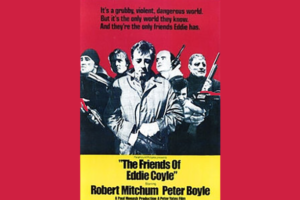
The Friends of Eddie Coyle (1973) Classic Movie Review 213
All you got to know is I told the man[...]
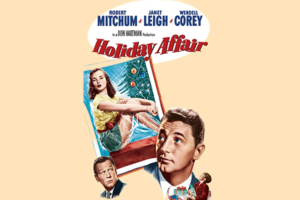
Holiday Affair (1949) Classic Movie Review 178
And I want a girl that’ll drop everything and run[...]
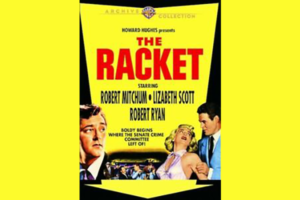
The Racket (1951) Classic Movie Review 303
Newspaper readers forget fast. It goes in one eye and[...]
Save my name, email, and website in this browser for the next time I comment.

© 2013 - 2024 · ClassicMovieRev.com
- Podcast Archive
- Social Media
- My Fiction Books
Type and press Enter to search
The Enemy Below

- Photos & Videos
Film Details
- Articles & Reviews
Brief Synopsis
Cast & crew, dick powell, robert mitchum, curt jurgens, theodore bikel, russell collins, photos & videos, technical specs.

In the South Atlantic during World War II, Lt. Ware, the second-in-command of the U.S.S. Haynes , a U.S. Navy destroyer escort, speculates with several crew members about the competency of their new commander, Capt. Murrell. Murrel, who has sequestered himself in his cabin, finally emerges when the ship's radar displays a mysterious shadow on its screen. Sensing the enemy, Murrell steadies his nerves and authoritatively assumes command. Meanwhile, in a German submarine cruising the heavy seas nearby, Comdr. Von Stolberg voices to his second-in-command, Schwaffer, his abhorrence of the "new Germany" and its tyrannical leader. Although committed to his mission of securing a British code book, Von Stolberg finds no honor in this particular war. On the American boat, meanwhile, Murrell and "Doc," the ship's dispirited physician, discuss their lives before the war. Murrell, a freighter captain in his civilian life, relates that he prefers the struggle of man against sea to man against man, but adds that he opted for the "shooting end of the war" after watching his wife drown when their freighter was torpedoed by a German submarine. In the morning, the Americans assume their battle stations, and Von Stolberg orders his submarine to submerge when he sees the ship approaching. As Murrell baits the Germans into firing a torpedo, the crew, skeptical of his strategy, anxiously awaits the outcome. When the Germans release their torpedoes, Murrell turns his ship in time, thus avoiding the missiles and winning the respect of his crew. After the German boat dives deeper, the Americans fire their depth charges, rattling the submarine. By reversing course, Von Stolberg loses his pursuers, but Murrell relocates the Germans and pummels them with depth charges. Von Stolberg responds by ordering his ship to dive to the ocean bottom, and the boat creaks and groans from the intense pressure. Deducing that the submarine is resting at the bottom of the sea, Murrell decides to wait in silence until it resurfaces. Sensing that the Americans are lying in wait, Von Stolberg feels that he is being tracked by the devil. Up above, meanwhile, Murrell awaits the arrival of approaching American ships and formulates a new tactic of attacking and then dropping back, hoping to force the submarine to surrender. At the bottom of the ocean, the Germans are beginning to crack under the strain and Von Stolberg rallies their morale by leading them in defiant song. When the American sonar picks up their static, Murrell feels sympathy for the trapped Germans but attacks anyway. Finally discerning the American's strategy, Von Stolberg pinpoints their ship's vulnerable spot and then orders a torpedo attack. Severely hit by the German torpedoes, the American ship starts to sink and Murrell orders the crew to torch some mattresses to make it seem as if the ship is on fire, hoping to entice the submarine to the surface. When the Germans emerge and signal that they will torpedo the American ship again in five minutes, Murrell feigns gratitude for the warning, plotting to lure the Germans close enough to attack. As the Germans approach, the Americans open fire with their artillery and then ram the submarine. While his crew abandons ship, Von Stolberg goes below deck to save the gravely injured Schwaffer. Back on deck, the opposing captains salute each other, and then Murrell throws Von Stolberg a rope so that he can construct a pulley to transport Schwaffer to the safety of the American boat. Manning the lifeboat, Ware spots Murrell and the two Germans aboard the destroyer. Aware that a detonator has been set on the submarine, Ware risks his life and the life of his crew to maneuver the lifeboat toward the destroyer. After the Americans convey the three to safety and clear the area, the detonator explodes, encompassing both ships in flames. Once they are rescued, the Americans and Germans hold a funeral at sea for Schwaffer, causing Doc to find new inspiration in their unification. Afterward, Murrell offers Von Stolberg a cigarette.

Kurt Kreuger

Frank Albertson
Biff elliot, alan dexter, doug mcclure, joe di reda, ralph manza, ted perritt, jimmy bayes, arthur la ral, dale cummings, sasha harden, roger cornwall, michael mchale, thomas beyl, frank obershall, robert boon, werner reichow, jack dailey, richard elmore, ronnie rondell, vincent deadrick, lee j. winters, maurice doner, jack kramer, robert whiteside, l. b. abbott, fay babcock, albert beck, leonard doss, comdr. c. e. dunston, stuart gilmore, leigh harline, charles henderson, albert hogsett, arthur l. kirbach, charles lemaire, harry m. leonard, arthur lueker, wendell mayes, lionel newman, edward b. powell, walter rossi, harold rosson, walter m. scott, lt. comdr. walter smith, eric stacey, lyle r. wheeler.

Hosted Intro

Best Special Effects
Best visual effects.

The Miami yacht races were never like this. - Lieutenant Ware
I guess you're finding the Sun kind of hard to take, after the North Atlantic. - Doctor
Oh, it doesn't matter. It's always either too cold or too hot, wherever there's a war on. - Captain Murrell
Well, in time we'll all get back to our own stuff again. The war will get swallowed up, and seem like it never happened. - Doctor
Yes, but it won't be the same as it was. We won't have that feeling of permanency that we had before. We've learned a hard truth. - Captain Murrell
How do you mean? - Doctor
That there's no end to misery and destruction. You cut the head off a snake, and it grows another one. You cut that one off, and you find another. You can't kill it, because it's something within ourselves. You can call it the enemy if you want to, but it's part of us; we're all men. - Captain Murrell
I have no idea what he is, what he thinks. I don't want to know the man I'm... trying to destroy. - Captain Murrell
Remember our talk on the bridge -- the weighty one, death and destruction? You might be interested to know that I've seen another reason for hope. Found it in a funny place, too... in the middle of an ocean, right in the middle of a war. - Doctor
You had to come a long way to find it, though, didn't you, Doc? - Captain Murrell
It was worth the trip. - Doctor
Maybe. - Captain Murrell
I should have died many times, Captain, but I continue to survive somehow. This time it was your fault. - Von Stolberg
I didn't know. Next time I won't throw you the rope. - Captain Murrell
I think you will. - Von Stolberg
The Original Series Star Trek episode "Balance of Terror" was based almost entirely on this film
Two endings were shot: In one, both commanders die; in the other, a third vessel rescues them. The final ending was determined by preview results. The USS Haynes was portrayed by the USS Whitehurst, captained by Walter R. Smith, who received a "technical advisor" credit and can be seen portraying the ship's chief engineer. Eva Novak can be seen in a photo as the wife of Von Stolberg.
The film closes with the following written acknowledgment: "Twentieth Century-Fox wishes to thank the Department of Defense and the United States Navy for their assistance in the production of this motion picture." According to studio production notes in the AMPAS Libary production file on the film, the destroyer escort U.S.S. Whitehurst , a battle-scarred veteran of World War II that was stationed in Pearl Harbor, HI, was the ship used for the film's fictional U.S.S. Haynes . Lt. Cmdr. Walter Smith, the skipper of the Whitehurst , served as a technical advisor on the film. According to studio publicity, Smith also played a bit part as the ship's chief engineer. However, the CBCS credits Robert Boon in that role. The actors spent a month aboard the Whitehurst during filming. Albert Beck, a former German submarine sailor, worked as technical advisor for the U-Boat sequences. The rescue sequence was filmed at Long Beach, CA aboard the U.S.S. Alfred E. Cunningham . According to a July 1957 Hollywood Reporter news item, the ending originally shot called for "Captain Murrell" and "Von Stolberg" to drown after Murrell plunges into the ocean to save Von Stolberg. Believing that this ending was too bleak, producer-director Dick Powell decided to film the alternate ending in which both commanders survive. The two endings were then shown to preview audiences, who preferred the more upbeat one. The Enemy Below marked the film debuts of Doug McClure, former Fox messenger boy Ted Perritt and Al Hedison, who later changed his name to David Hedison. It also marked the American-film debut of Curt Jurgens. Dan Tana, who later opened a famous eatery in Los Angeles, also made his screen debut in the picture. In a July 1977 New York Times article, Jurgens stated that "this was an important picture for me because it was the first film after the war in which a German officer was not interpreted as a freak." Other reviews commented that the film was notable because the clash between the captains was not portrayed as black and white or good and evil. Walter Rossi won an Academy Award for Best Audible Special Effects for his work on the production.
Miscellaneous Notes
Voted One of the Year's Ten Best Films by the 1957 National Board of Review.
Released in United States 1957
Released in United States 1998
Shown at Los Angeles County Museum of Art (LACMA) as part of program "Twentieth Century Fox and the Golden Age of CinemaScope" July 3 - August 15, 1998.
Director Dick Powell is also the actor.
Released in USA on video.
CinemaScope
Released in United States 1998 (Shown at Los Angeles County Museum of Art (LACMA) as part of program "Twentieth Century Fox and the Golden Age of CinemaScope" July 3 - August 15, 1998.)
Sign Up now to stay up to date with all of the latest news from TCM.

Your Browser is Not Supported
To view this content, please use one of the following compatible browsers:
Safari v11+
Firefox Quantum
Microsoft Edge

The Enemy Within (episode)
- View history
A transporter malfunction creates an evil Kirk.
- 1.2 Act One
- 1.3 Act Two
- 1.4 Act Three
- 1.5 Act Four
- 2 Log entries
- 3 Memorable quotes
- 4.1 Production timeline
- 4.2 Story and production
- 4.3 Props and sets
- 4.4 Special effects
- 4.5 Costumes
- 4.7 Continuity
- 4.8 Apocrypha
- 4.9 Preview
- 4.10 Reception
- 4.11 Syndication cuts
- 4.12 Video and DVD releases
- 5.1 Starring
- 5.2 Also starring
- 5.3 Featuring
- 5.4 Uncredited co-stars
- 5.5 Stunt double
- 5.6 Stand-ins
- 5.7.1 Unreferenced materials
- 5.8 External links
Summary [ ]
During a survey of Alfa 177 , geological technician Fisher slips down a rock, gashing himself badly and smearing his uniform with a strange magnetic type of yellow ore . He beams up to the USS Enterprise for treatment.
Detecting a curious overload in the transporter circuitry, Lieutenant Commander Montgomery Scott has Fisher decontaminated before reporting to sickbay , but the problems have already begun; the strange ore has altered the function of the transporter.
Next, Captain Kirk beams up from the planet , before the fault is discovered. He apparently materializes normally and Scott escorts the disoriented captain out of the room. Kirk is, in fact, a shadow of himself. Due to this transporter accident , Kirk has been split into two beings. The first that materialized embodies all of Kirk's positive qualities. Moments later, after Kirk and Scott have left, Kirk's evil twin — Negative Kirk — materializes in the transporter chamber.
Act One [ ]
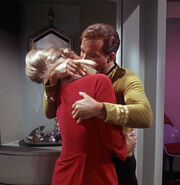
" Don't fight me, Janice! "
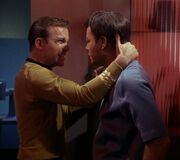
" I said give me the brandy! "
Some time passes before the mishap is discovered. Negative Kirk demands Saurian brandy from McCoy in sickbay and proceeds to roam the ship's corridors drunk. McCoy then informs Commander Spock about this, who then consults good Kirk about McCoy's concerns. Kirk shrugs it off, telling Commander Spock that McCoy was just pulling his leg.
Meanwhile, Negative Kirk, who is now instinctively consumed by lust for his beautiful Yeoman – Janice Rand – is alone with Rand in her quarters, drunk and amorous. Negative Kirk mentions to her the feelings they've been hiding, claiming she is " too beautiful to ignore, " and " too much woman, " and that they've both been " pretending too long. " Negative Kirk suddenly grabs Rand and shouts," Let's stop pretending! " He pulls her in close, put his arms around her, and mutters, " …Don't fight me, Janice. " He then starts kissing her very aggressively, and as she is forcefully trying to fight back, Negative Kirk pushes her to the floor and attempts to rape her. But she defends herself and leaves a large scratch on Negative Kirk's face. During the struggle, Negative Kirk attacks Crewman Fisher, who was walking by Rand's quarters and saw the attack.
In sickbay, a crying and flustered Rand tells Kirk, Spock and McCoy, that the Captain tried to assault her, an accusation Fisher corroborates. Kirk firmly denies having done so, whereupon Spock deduces that there must be a Kirk impostor aboard the Enterprise .
Act Two [ ]
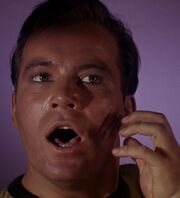
Negative Kirk has been scratched by Rand
Scotty finds that the yellow ore Fisher beamed up with somehow caused an overload in the transporter. The transporter does indeed work but they dare not use it for risk of duplicating Sulu and the rest of the landing party. Kirk tells Spock that he must inform the crew of what has happened to him, since they deserve to know. Spock, with all due respect, tells Kirk that as he is the captain, he cannot afford to be anything less than perfect in the eyes of the crew. If he does appear so, the crew will lose faith in him – and in turn, he will lose command of the Enterprise . Kirk knows this and wonders why he just forgot it just now. Later, on the bridge , Kirk makes an announcement to his crew from his chair about the impostor aboard. While making the announcement, Negative Kirk is rummaging through the captain's quarters. Kirk informs the crew that the impostor can be identified by scratches on his face, and warns the crew to set the phasers for stun and must not injure the impostor. Negative Kirk angrily destroys the captain's desktop monitor and rants at the top of his lungs " I'm Captain Kirk… I'M CAPTAIN KIRK!!! "
Negative Kirk goes to Kirk's mirror and finds make-up on the table. He applies some of it to his scratches and they are now barely visible. He opens the door to Kirk's quarters and finds Crewman Wilson walking down the corridor near the room. Negative Kirk asks Wilson for his phaser ; Wilson hands it over and is promptly knocked out. Later, both Kirk and Spock in the briefing room try to figure out where Kirk would go on the Enterprise to elude a mass search. Kirk quickly deduces that Negative Kirk is hiding in the lower levels of the ship – the engineering deck. He and Spock head there. In main engineering, a cat and mouse game ensues between the two Kirks and they confront each other near the warp core . Just as Negative Kirk is about to kill Kirk, Spock knocks him out with the Vulcan nerve pinch , but not before Negative Kirk's phaser accidentally discharges and a shot disables the transporter ionizer, making it harder to rescue Sulu and the landing party who are trapped on the rapidly freezing planet.
Act Three [ ]
Meanwhile, on the planet below, the remaining landing party is suffering through the increasingly bitter cold. Attempts to beam heaters and other support devices produce only non-functional duplicates. Kirk speaks to Sulu in the Enterprise 's briefing room, trying to reassure his helmsman, all the while growing more and more unsure of his command abilities. Spock cuts in and tells Sulu to hold on for just a little while longer.
Negative Kirk is screaming while being restrained on a bio-bed in sickbay, in pain from his body functions having been weakened from the duplication process. Kirk takes Negative Kirk's hand, tells him not to be afraid and to use his mind, rather than his savagery. McCoy takes Kirk aside for a brandy. Kirk realizes through McCoy that he needs his negative side of himself back but does not want it back. McCoy assures his captain that all Humans have a dark side to them and that his strength of command lies in his negative self.
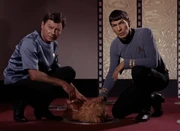
" He's dead, Jim. "
Finally, Scott and Spock believe they have isolated and repaired all the damage. Spock contacts Kirk and asks him to come down to the transporter room. An Alfa 177 canine test animal , previously split, is sent through to see if it will reintegrate. Spock and Scott subdue the fierce canine with a hypospray and place it beside its good self on the transporter pad. Spock and Fisher place the two canines on the transporter pad and Scotty energizes. " If this doesn't work, I don't know what will, " Scotty says. The good and fierce canines become one again, but it rematerializes dead from the shock from having suddenly had its two halves reintegrated forcefully.
Act Four [ ]
Negative Kirk recovers in sickbay while Sulu contacts Kirk from the planet, just before he succumbs to the extreme cold. Kirk decides to release his evil half and have both of them go through the transporter, but Negative Kirk attacks and overpowers Kirk in sickbay and dresses in Kirk's wraparound tunic. Later, heading to the bridge, Negative Kirk, pretending to be the good Kirk, runs into Janice Rand outside a turbolift and explains to her that the transporter malfunctioned, and that the animal part of him was in her cabin with her during the attempted rape. Negative Kirk, again posing as the good Kirk, also points out that the evil Kirk scratched his face to make them more alike. Arriving on the bridge, Negative Kirk orders navigator Lieutenant John Farrell to take the ship out of orbit and abandon Sulu along with the landing party, callously asserting that they cannot be saved. At this point, the good Kirk appears on the bridge with McCoy. At first, Farrell and the others are confused as to which one is the good Kirk, but soon Negative Kirk collapses under the strain – screaming and crying " I want to LIVE! " before falling into Kirk's arms.
Later, both Kirks are taken to the transporter room to be reintegrated as one being. Spock handles the transporter console and promises Kirk that he will take command of the Enterprise if the procedure is unsuccessful. Spock energizes the transporter and the two Kirks disappear. After a few tense moments, Spock materializes Kirk back in the transporter chamber as one person. To Spock and McCoy's relief, the much more confident Captain Kirk steps off the pad and orders that the landing party be rescued immediately. Sulu and the others are beamed back aboard, frostbitten but alive.
On the bridge, Rand awkwardly tries to explain to Captain Kirk what his impostor told her about what had happened and when she tries to elaborate further, Kirk simply thanks her and walks away. When Rand hands a PADD to Spock to sign, the first officer says to her, " The, uh, impostor had some interesting qualities, wouldn't you say, Yeoman? " She takes the PADD and stylus from him and walks away in a huff as Kirk orders that the Enterprise lift out of Alfa 177's orbit to continue its mission .
Log entries [ ]
- Captain's log, USS Enterprise (NCC-1701), 2266
Memorable quotes [ ]
" Oh! Captain! You startled me! Is there something that you… can I help you, Captain? " " Jim, will do here, Janice. " " Ooohhh… " " You're too beautiful to ignore… Too much woman. We've both been… pretending too long. "
" You can't afford the luxury of being anything less than perfect. If you do, they lose faith, and you lose command. "
" I'm Captain Kirk. I'M CAPTAIN KIRK!!! "
" And what is it that makes one man an exceptional leader? We see here indications that it's his negative side which makes him strong, that his evil side, if you will, properly controlled and disciplined, is vital to his strength. "
" If I seem insensitive to what you're going through, captain, understand: it's the way I am. "

Sulu on Alfa 177
" Do you think you might be able to find a long rope somewhere and lower us down a pot of hot coffee? " " I'll see what we can do. " " Rice wine will do if you're short on coffee. "
" Any possibility of getting us back aboard before the skiing season opens down here? "
" He's like an animal. A thoughtless, brutal animal. And yet it's me. Me! "
" We all have our darker side. We need it! It's half of what we are. It's not really ugly. It's Human. "
" The intelligence, the logic. It appears your half has most of that. And perhaps that's where man's essential courage comes from. "
" Being split in two halves is no theory with me, Doctor. I have a Human half, you see, as well as an alien half, submerged, constantly at war with each other. Personal experience, doctor. I survive it because my intelligence wins over both, makes them live together. "
" Janice! Hello. The animal part of me came to your cabin. He even scratched me to make us look more alike. I'd like a chance to explain it to you. You don't mind if I come to your cabin later? " " No, sir. "
" Can half a man live? "
" I want to live! "
" I've seen a part of myself no man should ever see. "
" The… impostor had some… interesting qualities, wouldn't you say, Yeoman? "
Background information [ ]
Production timeline [ ].
- Story outline by Richard Matheson : 4 April 1966
- Revised story outline: 22 April 1966
- First draft teleplay by Matheson: 25 April 1966
- Revised first draft teleplay: 19 May 1966
- Second draft teleplay: 31 May 1966
- Revised teleplay by John D.F. Black : 6 June 1966
- Final draft teleplay by Gene Roddenberry : 8 June 1966
- Additional revisions: 11 June 1966 , 15 June 1966
- Day 1 – 14 June 1966 , Tuesday – Desilu Stage 10 : Ext. Alfa 177 surface ; Desilu Stage 9 : Int. Transporter room
- Day 2 – 15 June 1966 , Wednesday – Desilu Stage 9 : Int. Transporter room
- Day 3 – 16 June 1966 , Thursday – Desilu Stage 9 : Int. Kirk's quarters , Bridge
- Day 4 – 17 June 1966 , Friday – Desilu Stage 9 : Int. Sickbay , McCoy's office
- Day 5 – 20 June 1966 , Monday – Desilu Stage 9 : Int. Sickbay
- Day 6 – 21 June 1966 , Tuesday – Desilu Stage 9 : Int. Engineering , Corridors , Janice Rand's quarters
- Day 7 – 22 June 1966 , Wednesday (Half Day) – Desilu Stage 9 : Int. Corridors , Briefing room
- Score recording: 14 September 1966
- Original airdate: 6 October 1966
- First UK airdate (on BBC1 ): 13 April 1970
- First UK airdate (on ITV ): 4 October 1981
- Remastered airdate: 26 January 2008
Story and production [ ]
- Writer Richard Matheson 's main influence on writing this episode was Dr. Jekyll and Mr. Hyde , as he envisioned Robert Louis Stevenson 's classic story put in a science fiction context. He eventually came up with the idea of the transporter causing a man to be split into two halves. [1]
- The subplot of Sulu and three other crewmembers stranded on the planet was not present in Matheson's original script, and was added in staff re-writes. Matheson did not like the idea, as he had an aversion to B-stories in general, believing they slowed stories down. He explained, " My script stayed entirely with Bill [Shatner] having this trouble of his two selves, on the ship […] They added a whole subplot about people down on the planet, ready to freeze to death, because they have [a] transporter functioning problem […] I stuck entirely with Bill." [2]
- The last two scenes of Act One are switched in order from what appears in the script. In the teleplay, Kirk and Spock learn about the assault of Janice in sickbay, then head to the transporter room, where they are faced with the discovery that the transporter is creating duplicates. The act ends with Scotty suggesting, " We don't dare beam up the landing party. If this should happen to a man… " and Kirk exclaiming, " Oh, my God! " In the episode itself, the sickbay scene follows the one in the transporter room, and the act ends with Spock declaring, "There's only one conclusion – we have an impostor aboard. " Director Leo Penn was known to reorganize scenes when he deemed them to be more dramatic in a different order from what was scripted. [3]
- In the final draft and the revised final draft of this episode's script, McCoy mused that part of "the Human condition" was having "an enemy within."
- Grace Lee Whitney once recounted that, while shooting the scene when a distraught, tearful Janice Rand accuses Captain Kirk of trying to rape her, William Shatner slapped her across the face to get her to register the proper emotion. [4] As they shot the rape scene days earlier, Whitney couldn't get into the same emotion successfully, and it was Shatner's "solution" to the problem. ( The Longest Trek: My Tour of the Galaxy , p. 94)
Props and sets [ ]
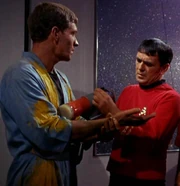
Scott and Fisher with scanner
- The scanning device used by Scott to scan the ore on Fisher's uniform appears to be a modified Nuclear-Chicago Model 2586 "Cutie Pie" radiation detector. [5] This Feinberger reappeared in " The Naked Time ", " The Doomsday Machine ", and " Obsession ".
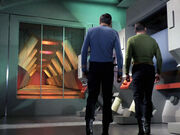
Spock and Kirk in engineering
- A shot, showing two extras ( Frank da Vinci and Ron Veto ) in red technician jumpsuits (and Veto holding the aforementioned "Cutie Pie" prop) in the engineering set was filmed, but cut from the episode. It was probably filmed as an insert shot for scenes at engineering. [6]
- The gauzy, red-bordered triangular set piece behind which the evil Kirk emerges briefly in engineering during the hunt scene appears to have been left over from the early briefing room as seen in " The Cage " and " Where No Man Has Gone Before ".
- The unit that Negative Kirk accidentally phasers in engineering was recycled as the housing for the main circulating pump for the PXK pergium reactor in " The Devil in the Dark ".
Special effects [ ]
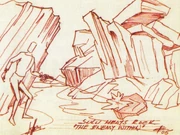
A sketch that Matt Jefferies did for the "Sulu heats rock" sequence
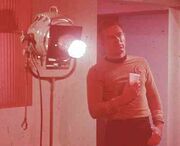
Shatner's photo double Don Eitner on set
- This is the only appearance of the showering phaser effect, used when Sulu heats the rock to provide warmth for himself and the other stranded on Alfa 177.
- There are two split-screen effects used: after Negative Kirk is neck-pinched by Spock; and in sickbay when Kirk takes the hand of his evil counterpart. All other instances of the two Kirks appearing in the same shot were achieved using stand-ins, who kept their faces turned away from camera: Eddie Paskey , who doubled as both Kirk and Negative Kirk; and stunt performer Don Eitner during the scene where Negative Kirk attacks Kirk in sickbay.
Costumes [ ]
- At the start of the episode when Kirk is beamed up from Alfa 177, both he and his evil counterpart are missing the Enterprise insignia on their uniforms. Lieutenant Farrell is also missing his insignia at some points during the episode (and also in a shot recycled from this episode in " Mudd's Women "). The Star Trek Compendium (3rd ed., p. 35) suggests that the insignia were removed every time the uniforms were cleaned (union rules required them to be cleaned daily); and during production of this episode, someone forgot to replace the insignia on Kirk and Farrell's uniforms.
- The first season version of the captain's wraparound tunic was created for this episode, with the original purpose of differentiating Kirk from Negative Kirk. It reappears in " Charlie X " and " Court Martial ", and in Kirk's briefcase in " This Side of Paradise ". The tunic was constructed of wool crêpe fabric, in contrast to the velour of the standard duty tunics.
- Although Nichelle Nichols does not appear in this episode, her voice is heard on the intercom in several scenes.
- Frank da Vinci and Ron Veto together had a deleted scene in this episode.
- Edward Madden previously played an Enterprise geologist in " The Cage ".
Continuity [ ]
- This episode marks the first time on screen that Kirk is duplicated in some form or fashion. This repeats again through " What Are Little Girls Made Of? ", " Whom Gods Destroy ", " The Survivor " and Star Trek VI: The Undiscovered Country .
- Spock's log entry in this episode calls himself "Second Officer Spock", however, in "Court Martial" the computer lists him as "First Officer Spock" and from then on is referred to as a "first officer" until his return in Star Trek: The Motion Picture as simply science officer .
- This was the first episode to be produced to show the Vulcan nerve pinch , as well as the first time McCoy says " He's dead, Jim ." Leonard Nimoy objected to the script's directive that Spock "kayoes" Negative Kirk on the head, so he improvised the neck pinch on the spot and demonstrated it on William Shatner for director Leo Penn. ( Star Trek Encyclopedia (3rd ed., p. 550)) The script's original directive survives to this day in the James Blish adaptation of this episode (in the book Star Trek 8 ) as Blish only had access to the scripts and not to the finished episodes.
- The transporter was depicted as the only mode of transport between a planet and the ship because this episode was written and filmed before the existence of the hangar deck and shuttlecraft were established, even though both of these locations are clearly built into the studio model of the Enterprise as seen in the episode. As the lack of a shuttlecraft was almost immediately pointed out as a plot error, production and writing staff later stated that perhaps the shuttlebay was simply out of service for repairs during this episode, which would explain why the crew did not use shuttles to rescue their comrades ( Star Trek Compendium [ page number? • edit ] )
- This episode establishes that the phaser two unit consists of a phaser one unit fitted into a pistol mount. Sulu can be seen doing this just before he phasers the rocks for warmth. This procedure is not seen in any other episode.
- In the sequence of aired episodes, this is the first episode where we see or hear the new middle initial for James Kirk. "Captain James T. Kirk" is briefly visible as Negative Kirk enters Kirk's quarters. The initial was first spoken in " Mudd's Women ", but that episode aired after "The Enemy Within".
- In the latter part of the scene where the two Kirks appear together on the bridge, a close-up shot of the Negative Kirk shows the scratches on the right side of his face, although wider shots (and all earlier scenes) showed they were on the left side. This was due to the shot being reversed during editing. Director Leo Penn and cameraman Jerry Finnerman mistakenly filmed the close-up out of axis, breaking the 180-degree rule, and editor Fabien Tordjmann could only help by reversing it, hoping the audience wouldn't notice the resulting continuity error. ( These Are the Voyages: TOS Season One , 1st ed. p. 157)
- A reaction close-up shot of Spock on the bridge is recycled from " The Naked Time ". The same shot was used again in " The City on the Edge of Forever ".
Apocrypha [ ]
- In the novel Foul Deeds Will Rise , the duplication witnessed here is documented as 'the Alfa Effect', with another character duplicating the effect to give herself an alibi for various murders (One of her appears in public while the other commits the crimes), claiming to have adjusted the balance so that both duplicates share the same personality traits as opposed to the imbalance witnessed here (although the duplicates do demonstrate a divergence later, with one being more violent while the other accepts their failure).
- A cat version of "The Enemy Within" was featured in Jenny Parks ' 2017 book Star Trek Cats .
Preview [ ]
- The preview contains a Captain's Log recorded solely for the preview, but based on one from the finished episode: " Captain's log, stardate 1672.9. Due to the malfunction of the ship's transporter, an unexplained duplicate of myself exists. "
Reception [ ]
- Actress Grace Lee Whitney was very unhappy about the last scene of this episode, in which Spock asks Yeoman Rand , " The impostor had some very interesting qualities, wouldn't you say, Yeoman? " In her autobiography, she wrote: " I can't imagine any more cruel and insensitive comment a man (or Vulcan) could make to a woman who has just been through a sexual assault! But then, some men really do think that women want to be raped. So the writer of the script (ostensibly Richard Matheson – although the line could have been added by Gene Roddenberry or an assistant scribe) gives us a leering Mr. Spock who suggests that Yeoman Rand enjoyed being raped and found the evil Kirk attractive! " ( The Longest Trek: My Tour of the Galaxy , p. 95)
- Despite this, Whitney enjoyed this episode. " I liked 'The Enemy Within' because seeing Captain Kirk act in that fashion challenged me as an actress. " ( Starlog #105, April 1986 , p. 49) Several years later she echoed those sentiments, stating " I love "The Enemy Within" because it gave me a chance to really react and act with Bill Shatner. I love it! I loved the whole concept of him breaking into two characters because that really was what Kirk and Rand were about. There were two sides of Kirk and two sides of Rand. Rand was there to be of service to him but she was also in love with him. But she knew she mustn't go over-go the boundaries. " ( These Are the Voyages: TOS Season One , p. 159)
- James Doohan stated that he thought William Shatner 's performance in this episode was " pretty okay. " ( Beam Me Up, Scotty , p. 132)
- Director Leo Penn also praised Shatner's performance. " William Shatner's a very good actor and gave a very good performance… I had a good time on that show. " ( These Are the Voyages: TOS Season One , 1st ed. p. 159)
- Richard Matheson elaborated, " I thought Bill Shatner was brilliant. I loved what he did. He carried the whole thing. I was a little sorry that Roddenberry put so much emphasis on the crew being stuck on the planet […] But I liked it and I was very satisfied with the production value. " ( These Are the Voyages: TOS Season One , 1st ed. p. 159)
- Roddenberry picked this as one of his ten favorite episodes for the franchise's 25th anniversary. ( TV Guide , August 31, 1991 [ page number? • edit ] )
- When first screened in the United Kingdom in 1970, the BBC partially edited the episode, specifically the scene where Negative Kirk attacks Janice. The cuts remained until the 1992-94 repeat run. [7]
Syndication cuts [ ]
During the syndication run of Star Trek , the following scenes were typically cut from broadcast:
- Extended scene of Scott preparing to beam Kirk up to the ship.
- A longer conversation between Spock and Kirk about Negative Kirk demanding brandy from McCoy.
- Extended scene of Negative Kirk in Rand's quarters.
- Additional segments of discussion with Rand and Fisher in sickbay.
- Extra dialogue between Kirk and Spock, followed by another scene showing the two entering engineering to look for Negative Kirk.
- Longer reports from Sulu on the surface of the planet, including a split scene of Sulu speaking to Kirk, then a shot of the Enterprise in orbit, followed by Kirk's reply.
Video and DVD releases [ ]
- Original US Betamax/VHS release: 28 February 1985
- Original UK VHS release (two-episode tapes, CIC Video ): Volume 3 , catalog number VHR 2244, release date unknown
- US VHS release: 15 April 1994
- UK re-release (three-episode tapes, CIC Video): Volume 1.2, 8 July 1996
- Original US DVD release (single-disc): Volume 2, 17 August 1999
- As part of the TOS Season 1 DVD collection
- As part of the TOS Season 1 HD DVD collection
- As part of the Star Trek: Fan Collective - Alternate Realities collection
- As part of the TOS Season 1 Blu-ray collection
Links and references [ ]
Starring [ ].
- William Shatner as James T. Kirk
Also starring [ ]
- Leonard Nimoy as "Mr. Spock "

Featuring [ ]
- DeForest Kelley as "Dr. McCoy "
- Grace Lee Whitney as "Yeoman Rand "
- George Takei as " Sulu "
- James Doohan as " Scott "
- Edward Madden as " Fisher "
- Garland Thompson as " Wilson "
- Jim Goodwin as " Farrell "
Uncredited co-stars [ ]
- Nichelle Nichols as Uhura (voice only)
- Eddie Paskey as Leslie
- Communications officer
- Sciences technician 1
- Sciences technician 2
- Section chief (voice only)
Stunt double [ ]
- Don Eitner as the body double for William Shatner
Stand-ins [ ]
- William Blackburn as the stand-in for DeForest Kelley
- Frank da Vinci as the stand-in for Leonard Nimoy
- Jeannie Malone as the stand-in for Grace Lee Whitney
- Eddie Paskey as the stand-in for William Shatner
References [ ]
abort control circuit ; Alfa 177 ; Alfa 177 canine ; alter ego ; animal ; announcement ; annoyance ; answer ; assignment ; autopsy ; bank ; base cycle ; bed ; body ; body function panel ; " Bones "; burnout ; bypass circuit ; cabin ; casing ; circuits ; coadjutor engagement ; coffee ; communication line ; compassion ; confusion ; consciousness ; Constitution -class decks ; courage ; decontamination ; degree ; dizziness ; duty officer ; Earth ; easel ; engineering ; engineering deck ; evil ; exposure ; eye ; face ; fear ; feeling ; force of will (aka strength of will ); frost ; frostbite ; full postmortem ; geological technician ; good ; hand ; hand phaser ; hostility ; hotline ; Human ; impostor ; impulse engine ; intellect ; intelligence ; kiss ; landing party ; leader ; leader circuit ; logic ; love ; lust ; magnetism ; main circuit ; make-up ; microtapes ; mind ; mirror ; name ; neck ; opportunity ; ore ; overload ; painting ; phaser weapon ; plan ; pot ; protoplaser ; power generator ; quality ; quarters (cabin); rape ; rice wine ; risk ; rock ; room ; room service ; rope ; Saurian brandy ; savage ; search ; search party ; second officer ; section ; section chief ; ship's manifest ; shock ; skiing season ; specimen ; specimen case ; specimen gathering mission ; status report ; store ; temperament ; surface temperature ; survival procedure ; sympathy ; synchronic meter ; temperature ; terror ; theory ; thermal heater ; time sheet ; training program ; tranquilizer ; transporter ; transporter circuit ; transporter malfunction ; transporter technician ; transporter room ; transporter unit ; transporter unit ionizer ; truth ; unconsciousness ; vacation ; velocity balance ; violence ; Vulcan nerve pinch ; " watching the store "; week ; wild man ; will ; yellow
Unreferenced materials [ ]
Churchill, Winston ; Heaven ; Hell ; malingerer ; nuclear energy ; nurse maid ; power plant ; rattle ; traffic signal ; Truman, Harry S.
External links [ ]
- " The Enemy Within " at Memory Beta , the wiki for licensed Star Trek works
- " The Enemy Within " at Wikipedia
- " The Enemy Within " at the Internet Movie Database
- " The Enemy Within " at MissionLogPodcast.com , a Roddenberry Star Trek podcast
- 3 ISS Enterprise (NCC-1701)
10 Star Trek Episodes Based On Real-Life Events
These may be set in the Final Frontier but each of these episodes are based on a True Story.

Star Trek has always been able to shine a light on contemporary issues by depicting them through the lens of SciFi. This gives them great licence in how they can approach topics that may be considered sensitive for prime time viewing, though of course this is less of an issue in the age of streaming.
Star Trek's Original Series took many stories of then-modern incidents, particularly those in WW2 and the Cold War, bringing them to life on-screen. The Romulans have stood in for both the Russians and the Chinese Superpowers from time to time, with the Klingons also taking their share of the former's time as well.
Disease, poverty and violence are all heady topics to tackle in a show about space exploration, yet the franchise has managed in its almost sixty year span to bring some incredibly serious historical moments into the canon, whether it be a certain Victorian Ripper or devastating epidemics.
There are 'true' stories out there to be mined as well, including a little story from the United States, featuring a downed weather balloon, some little green men and a big army conspiracy. And for proof on that one, we have [ REDACTED].
10. Balance Of Terror
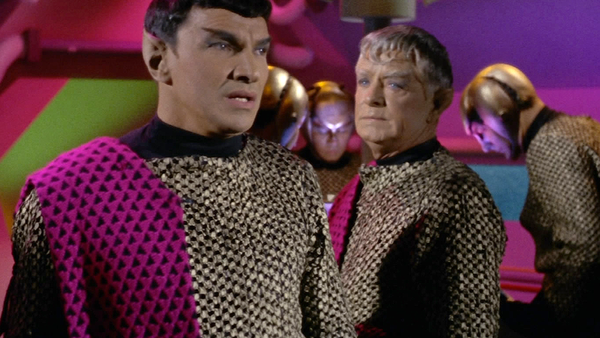
Balance of Terror introduced the Romulans to Star Trek, with the Enterprise hunting down the invisible Romulan Bird-of-Prey. The episode is an exercise in tension, with frequent visits to the bridges of both ships. The big reveal, that the Romulans are off-shoots of the Vulcans, leads to an exploration of bigotry and racism in the Star Trek universe as well.
The episode is Star Trek's answer to the 1957 film The Enemy Below, an adaptation of the 1956 novel of the same name. Both were based on the Battle of the Atlantic, the longest continuous campaign during the Second World War. It began just after the declaration of war in 1939 and lasted until the surrender of NAZI Germany in 1945. It was a strategic victory for the Allied forces, with the German blockade of Britain etc failing, though it was a pyrrhic victory, with thousands of lives lost.
In the episode, the action is confined to two vessels, with the Romulans playing the part of the U-Boats. Though the Enterprise emerges victorious, both commanders reflect on the pointlessness of the battles they are waging. Balance of Terror is one of the most sombre episodes of Star Trek, frequently appearing on top ten lists of the show.
Writer. Reader. Host. I'm Seán, I live in Ireland and I'm the poster child for dangerous obsessions with Star Trek. Check me out on Twitter @seanferrick
My Star Trek Reviews
Jeremy A Perron's multiple year mission to complete an interesting and witty review for every Star Trek series, every movie, and maybe branch out into my novel collection. Spoilers! Spoilers! Spoilers beware!
Saturday, October 12, 2019
Introducing the romulans: the enemy below of space.


No comments:
Post a comment.
- Show Spoilers
- Night Vision
- Sticky Header
- Highlight Links

Follow TV Tropes
http://tvtropes.org/pmwiki/pmwiki.php/Film/TheEnemyBelow
Film / The Enemy Below
Edit locked.

"I should have died many times, Captain, but I continue to survive somehow. This time it was your fault."
The Enemy Below is a 1957 war film directed and produced by Dick Powell , which shows the battle between the captain of an American destroyer escort and the commander of a German U-boat during World War II . It stars Robert Mitchum and Curd Jürgens . The film was based on a novel by Denys Rayner, a British naval officer involved in anti-submarine warfare throughout the Battle of the Atlantic.
Walter Rossi received the 1958 Academy Award for best special effects. The script was Recycled In Space as the classic Star Trek episode "Balance of Terror" .
This film provides examples of
- Adaptational Heroism : The final scenes of mutual respect and potential friendship between the protagonists are not present in the original book, where the Allied ship is British instead of American and the destroyer escort captain loathes his German counterpart and they both engage in fisticuffs.
- Adaptational Nationality : In the book, the Allied ship is British. In the film, it's American.
- A Father to His Men : Von Stolberg is very protective and compassionate towards his crew, and they are unflinchingly loyal to him in return. Murrell is also shown to care deeply for his men, but they haven't gotten to know him yet and have their doubts.
- Burial at Sea : 'Heinie' Schwaffer dies of his injuries and is buried at sea in the final act of the film.
- The Captain : Murrell and von Stolberg.
- Chromosome Casting : The only characters in the film are the all-male crews of a U.S. Navy ship and a German U-boat.
- Cool Boat : A German U-boat vs an American Buckley -class destroyer escort. Bonus points for filming on a real Buckley -class DE.
- Doomed Hurt Guy : Heinie .
- The Hunter Becomes the Hunted : The destroyer escort and the U-boat play cat and mouse throughout the film, but the submarine is extremely bold and dangerous as its role is not merely defensive.
- Mutual Kill : Both the destroyer and the submarine are sunk at the end, though the majority of both crews survive and are rescued.
- Von Stolberg's Establishing Character Moment shows him entering the control room soaking wet after standing watch on the bridge during a rain squall and becoming visibly annoyed when he sees that his newest officer has painted a Nazi propaganda slogan on one of the overhead pipes. He pointedly tosses his towel over it as he walks by.
- Ramming Always Works : The destroyer escort rams the U-boat as a last resort option. Truth in Television , this was a common tactic during WWII. The climactic battle even plays out with many similarities to the real-life duel between USS Buckley and U-66 , though in the real incident only the U-boat was sunk.
- Reality Has No Subtitles : Most of the time the crew of the German U-boat speak in English to each other for the audience's benefit, but a few times they speak in untranslated German. In the Burial at Sea scene at the end, the sub's captain speaks entirely in German.
- Sensor Suspense : ASDIC/SONAR pings.
- Shown Their Work : The movie displays a high level of technical accuracy on the destroyer escort and the U-boat. Uniforms, procedures, sensors, and weapons are all accurately depicted. Hollywood Tactics is completely averted.
- Stern Chase : A destroyer escort vs submarine duel.
- The German U-boat captain falls for one of the oldest tricks in the book - the American ship pretending that after being torpedoed, it's helpless and can't move or attack - and decides to surface. Under the laws of war, the American captain would have been completely justified in immediately opening fire on the U-boat with his deck guns and trying to ram it. The American captain even lampshades how stupid the U-boat captain's action is: "I'm half surprised he took the bait. That's the first foolish thing he's done."
- After warning the American ship that he would fire a second torpedo in ten minutes, the U-boat captain decides to wait on the surface for the entire ten minutes. Unfortunately, the American ship is still capable of movement and manages to ram the U-boat, leading to their mutual sinking. If the U-boat captain had just submerged after giving the American ship the warning and fired the torpedo while underwater, he could have avoided this.
- The U-boat captain had to know that other American warships were on the way. By sticking around, even for only ten minutes, he took the risk that American ships could arrive, detect him, and continue the attack upon his vessel. If he had to make sure of the American ship's sinking, he should have fired the second torpedo immediately. If he couldn't ethically do that, he could have just slipped away quietly and continued on his way.
- Took a Level in Badass : Captain Murrell was a Merchant Marine officer and later an active duty lieutenant commander in the Naval Reserve. He's still recovering from the sinking of his previous ship and the death of his wife and his ability is questioned by his underlings, but he shows his competency as a destroyer escort commander early on.
- The Von Trope Family : Von Stolberg has an aristocratic background and is not enamoured with the Nazi regime.
- War Is Hell : While the film is a straight war-adventure-suspense story, it does touch on the aspects: Captain Murrell lost his British wife to a U-boat when he was trying to evacuate her from Britain on his ship when he was a merchant mariner. Von Stolberg has lost his sons in battle ("one is at the bottom of the sea, and this one is a cinder in a burned airplane"), and doubts he's on the right side of the war. The two of them—honorable, intelligent, and compassionate men who respect each other's abilities—spend most of the film trying to kill each other.
- Worthy Opponent : U-boat captain von Stolberg is a honourable antagonist of destroyer escort captain Murrell. The two share a mutual respect for the other.
- Eight Hours of Terror
- Films of the 1950s
- A Face in the Crowd
- Emperor of the North
- Creator/20th Century Studios
- Enemy at the Gates
- Military and Warfare Films
- Escape from Sobibór
- The Cruel Sea
- WorksSetInWorldWarII/Films Set in World War II
- AmericanFilms/D to G
- Down Periscope
- Sea Stories
Important Links
- Action Adventure
- Commercials
- Crime & Punishment
- Professional Wrestling
- Speculative Fiction
- Sports Story
- Animation (Western)
- Music And Sound Effects
- Print Media
- Sequential Art
- Tabletop Games
- Applied Phlebotinum
- Characterization
- Characters As Device
- Narrative Devices
- British Telly
- The Contributors
- Creator Speak
- Derivative Works
- Laws And Formulas
- Show Business
- Split Personality
- Truth And Lies
- Truth In Television
- Fate And Prophecy
- Edit Reasons
- Isolated Pages
- Images List
- Recent Videos
- Crowner Activity
- Un-typed Pages
- Recent Page Type Changes
- Trope Entry
- Character Sheet
- Playing With
- Creating New Redirects
- Cross Wicking
- Tips for Editing
- Text Formatting Rules
- Handling Spoilers
- Administrivia
- Trope Repair Shop
- Image Pickin'
Advertisement:
- Buy the Book…
- Reviews Hub

the m0vie blog

Following Us
- Adding Our RSS Feed to Your Gmail
- Following our Feed in Internet Explorer
- Millennium (Reviews)
- Star Trek: Deep Space Nine (Reviews)
- Star Trek: Enterprise (Reviews)
- Star Trek: The Next Generation (Reviews)
- Star Trek: The Original Series (Reviews)
- Star Trek: Voyager (Reviews)
- The X-Files (Reviews)
- X-Files Fandom Poll Form
Check out the Archives

Awards & Nominations

Star Trek – The Enemy Within (Review)
To celebrate the release of Star Trek: Into Darkness this month, we’ll be running through the first season of the classic Star Trek all this month. Check back daily to get ready to boldly go. It’s only logical.
One thing that I don’t think the original Star Trek gets nearly enough credit for is the quality of the writers that Gene Roddenberry recruited to contribute scripts. Television obviously operated under a different model at the time, but there’s an impressive selection of science-fiction literary giants who contributed scripts to the show. More than that, it’s impressive how many of those stories became truly iconic Star Trek stories.
The Enemy Within is the work of author Richard Matheson, best known for stories like I Am Legend or What Dreams May Come . It’s very much a high-concept science-fiction story, but it’s also notable because it establishes two of what would become the show’s favourite tropes: transporter accidents and evil duplicates. Indeed, the two devices would be reunited in the following season’s Mirror, Mirror . These narrative elements even featured in the last season of Star Trek: Enterprise to air, in episodes like Daedalus and In a Mirror, Darkly .
Perhaps it’s a demonstration of how important these outside writers were to the development of Star Trek as a franchise that Matheson would effectively codify two stock narrative devices that would still be in use four decades later.
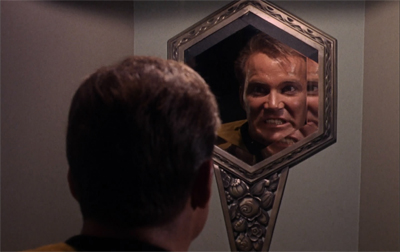
Mirror, mirror…
Of course, Matheson wasn’t the only science-fiction writer of that calibre to write for Star Trek . Harlan Ellison wrote The City on the Edge of Forever , while Theodore Sturgeon wrote Amok Time , with Norman Spinrad contributing The Doomsday Machine . That’s saying nothing of Larry Niven writing for Star Trek: The Animated Series . Outside of writers known for science-fiction, What Are Little Girls Made Of? came from the author of Psycho , Robert Bloch.
Those are some very important names, and they are names that immediately establish the pedigree of Star Trek . The involvement of these iconic science-fiction writers demonstrates that the show is more than merely a western in a novel setting. Instead, these names demonstrate that Star Trek is legitimate science-fiction, with all the high-concepts and big ideas that come with it. I am not, of course, suggesting that the absence of any or all of these names would put paid to the suggestion that Roddenberry was producing a science-fiction show, but their presence serves as an acknowledgement of what the creator was attempting to accomplish with the show.
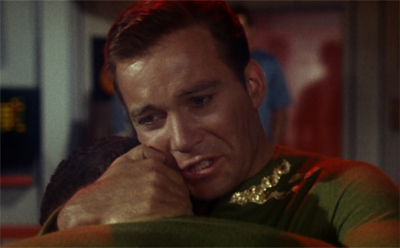
Kirk always was a bit in love with himself…
To be fair, some of these experiences would be least than pleasant. Harlan Ellison’s foreword to the book collecting his initial work on The City of the Edge of Forever offers a particularly bitter account of how difficult working within the show could be. At least Matheson didn’t have to worry about too much aside from what he felt to be an unnecessary b-plot unfolding on the planet below. Given that it eats up about five minutes of the episode, I think we can forgive it that.
Despite these teething problems, it’s hard to deny the results. William Shatner – writing in Star Trek Memories – credits strong stories like The City on the Edge of Forever for keeping Star Trek alive at the end of its first year in production. While Ellison tends to (deservedly) generate the most discussion about these respected authors working on Star Trek , his work is indicative of one of the greater strengths of the show. In fact, I think that the contributions of the other established science-fiction writers are occasionally overlooked.

Shatner dials it up…
These writers deserve credit for demonstrating that Star Trek was a fascinating avenue for compelling and exciting televised science-fiction. It’s something of which the spin-offs may have lost sight. Star Trek: The Next Generation and the later shows tended to the work of an established writing staff. That said, the shows welcomed unsolicited scripts from outside the office. This is, for example, how they recruited Ronald D. Moore for the third season of The Next Generation . However, there didn’t seem to be a conscious effort to court established science-fiction writers to contribute to television’s largest on-going science-fiction franchise.
Then again, it’s hard to complain about the consistent quality The Next Generation and Deep Space Nine once they got past their first two years, but it does feel like the spin-offs were missing something that had been a vital ingredient to Star Trek . You could argue that the model of television had changed in the years since Star Trek went into cancellation, but that’s hardly fair. Russell T. Davies and Steven Moffat have made it a point to invite established writers on to Doctor Who , to great success. Neil Gaiman wrote the acclaimed The Doctor’s Wife , while Richard Curtis wrote the much-loved Vincent and the Doctor .
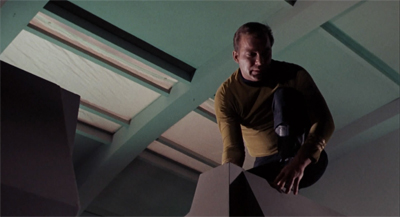
On the prowl…
Being honest, it’s clear that Star Trek owes Richard Matheson a fairly significant debt. The Enemy Within is very much an archetypal Star Trek episode. In fact, I suspect it is one of the few stories that ripples around in the broader public consciousness. While evil! Kirk might not be as iconic as goatee! Spock, I think that William Shatner’s portrayal of Kirk’s primal id is one of the most memorable images of the series. I also suspect that this is where Shatner established his reputation for scenery-chewing among the public at large.
The plot of The Enemy Within is relatively simple. In fact, it’s so simple that it would provide the basis for Mirror, Mirror the following season – albeit with the two ingredients inverted. Here, a transporter malfunction sends an evil version of Captain Kirk to the regular Enterprise. In Mirror, Mirror , a transporter malfunction sends the regular version of Captain Kirk to an evil Enterprise. It’s not to suggest that Mirror, Mirror is a rip-off of The Ene my Within . It’s just to illustrate that Matheson has crafted a simply story that effectively establishes two narrative staples of Star Trek .
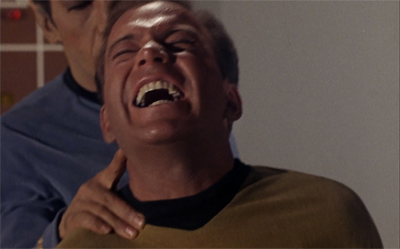
To be fair, half the cast wanted to do that at one point or another…
In a way, The Enemy Within is effectively an update of The Strange Case of Dr. Jekyll and Mr. Hyde . Transporter proves itself remarkably unreliable for only the first time in Star Trek history, somehow splitting Kirk into two halves. One half embodies all of Kirk’s best qualities, and the other half contains all his negative attributes. This is, of course, pure scientific nonsense, but it allows for an interesting story and a nice allegory. Plus we get to witness Shatner demonstrating his dramatic abilities in his portrayal of good! Kirk, which is a surprisingly nuanced performance.
One which is, admittedly, overshadowed by his campy turn as evil! Kirk. Even then, it’s work noting that Shatner’s portrayal of Kirk’s rampaging id personified is strangely compelling. As I mentioned above, it’s fair to argue that Shatner’s reputation of a hammy over-actor was cemented here. evil! Kirk poses, pantomimes, screams, spits and shouts. You could make a legitimate argument that evil! Kirk isn’t just a concentration of Kirk’s darker side, but also the embodiment of Shatner’s tendency to go over the top.
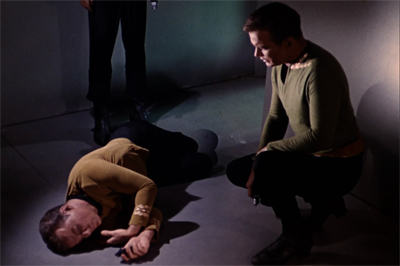
Double trouble…
This isn’t the first time that Shatner’s campy tendencies have been on display. We’d seen hints of his hammy-ness at the climax of Where No Man Has Gone Before , as Shatner milked Kirk’s appeal to Denher’s humanity for all it was worth. Still, evil! Kirk is arguably the furthest that Shatner would go off the reservation during the three-year run of Star Trek . Still, there is some skill here. Shatner cannily plays him as more animal than man. He crouches, lurches and swings aggressively. His movements are exaggerated, with Shatner making sure that the audience is aware that this is evil! Kirk in action.
In fact, for all the episode’s fixation on Kirk’s “doppelgänger” , Shatner makes it quite obvious which version of Kirk is which. The crew might be confused, but Shatner’s performance makes certain that we never are. And, to be fair, this isn’t a bad thing. After all, the premise is delightfully simplistic. This is a story where a magic technology can somehow rend a man’s soul in twain. It is not a subtle tale. Indeed, it’s hard to imagine a more subtle performance working as well as Shatner’s decision to gleefully chew the scenery.
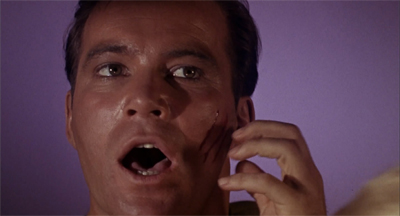
Just scratching the surface…
I will concede that the characterisation on classic Star Trek was not the strongest. Still, I think that the leading trio were drawn very clearly very early on, and I’d argue that the movies did a great job extending the characterisation of the main characters. Still, for all that The Enemy Within is a science-fiction high-concept, it is hard to see the plot working with any Star Trek captain other than James Tiberius Kirk.
Shatner’s Kirk has a roguish charm to him that is lacking from his successors. We don’t doubt that he’s sincere and that he is a good man, but there’s a darkness lurking underneath Kirk’s charming exterior. Kirk is the most dynamic and physical of the Star Trek leads, the one who isn’t afraid of violence, the one who indulges almost recklessly in casual sex with random women. (In fact, he even winds up with a son he never knew about.) Kirk has wit and skill, but he’s also reckless. He leads away teams into danger and there’s a sense that Kirk gets a vicarious thrill out of high-stakes contests.
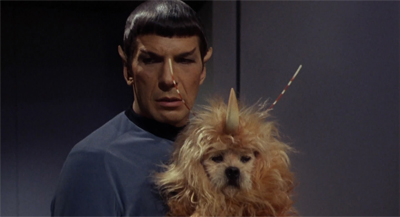
And your little dog, too!
In short, there’s a sense of something very sinister hiding behind all that charm. Shatner might not be the strongest actor in the history of television, but he gets Kirk. He embodies the character perfectly. Even when the scripts portray Kirk as an enlightened and sophisticated 23rd century man, Shatner makes it clear that there’s something primal lurking beneath. It’s not for nothing that he turns out to be so damn good at all those crazy gladiatorial contests.
So there is something to split here – two palpable facets of Kirk’s persona that can be separated from one another. Freed of the pragmatic cynicism of his darker half, good! Kirk trusts his crew to understand what has happened. He wants to disclose absolutely everything, including the fact that half of him is a de facto attempted rapist. “Yes, I’ll make an announcement to the entire crew, tell them what happened,” he assures Spock. “It’s a good crew. They deserve to know.”
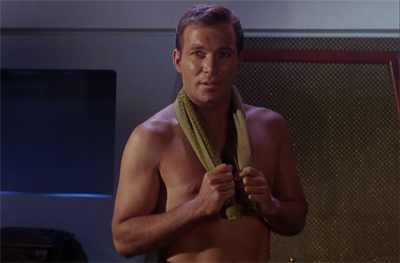
Keep your shirt on…
It’s not necessarily a stupid position, just an idealistic. After all, Kirk has served with this crew for some time now. He knows them, he respects them; many of them are his friends. However, as Spock points out, he doesn’t have the luxury of indulging his conscience. “Captain, no disrespect intended,” Spock responds, “but you must surely realise you can’t announce the full truth to the crew. You’re the Captain of this ship. You haven’t the right to be vulnerable in the eyes of the crew. You can’t afford the luxury of being anything less than perfect. If you do, they lose faith, and you lose command.”
In a weaker story, good! Kirk would be an emotional idealist without any self-restraint. He would wallow in self-pity and guilt for everything he has ever done. Here, instead, he’s simply a decent man constrained by his inability to compromise, to make sacrifices, to be ruthless for the greater good. evil! Kirk is willing to order the ship to abandon Sulu and the away team without a care. good! Kirk can barely bring himself to sacrifice a dog to test the transporter. “Don’t hurt him,” good! Kirk asks Scott.
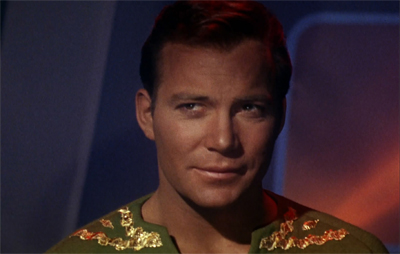
Putting it all together…
It’s a nice plot point – the idea that Kirk owes some of his strength to something approaching ruthlessness and brutality. Without that darker half, good! Kirk is somewhat impotent. He can’t barely order Spock to call him out on it. “Mister Spock, if you see me slipping again, your orders… your orders are to tell me.” He concedes that, due to the separation, he has lost his “strength of will.” It’s interesting to see Star Trek concede that some of these darker drives are necessary or even useful. The show is generally so idealistic, that such a concession seems a little weird. In fact, Grace Lee Whitney protests that argument in her biography, The Longest Trek .
Indeed, it’s this sort of attitude that would be missing from a lot of the first season of The Next Generation , as Roddenberry insisted that the show present the crew as completely flawless. However, the key isn’t necessarily to completely purge the darker aspects of the human psyche – after all, those are essential parts of ourselves. It’s difficult to relate to the perfect humans of The Next Generation in the show’s first year because they are so perfect that they don’t seem human.
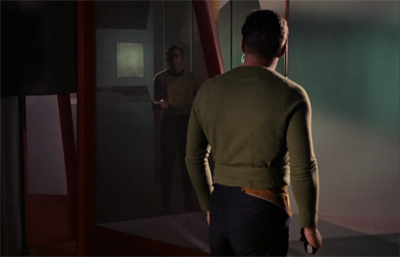
Face-to-face…
“We all have our darker side,” McCoy argues. “We need it! It’s half of what we are. It’s not really ugly, it’s human.” That’s the key right there, and Star Trek has always been as much about exploring the human condition as it has been about charting the final frontier. It has – at its best – about exploring who we are and what makes us human. The Enemy Within might not be subtle, but it is effective. It uses the backdrop of science-fiction to comment on mankind and our relationship with ourselves and the wider universe.
That said, there are some problems. It is very tough to watch the scene where Kirk tries to sexually assault Rand, knowing that Grace Lee Whitney would be sexually assaulted herself a few weeks later, on the set of Miri . The scene isn’t gratuitous or especially problematic of itself, but it’s very tough to watch knowing that Whitney would be assaulted by an anonymous studio executive only a little while later.
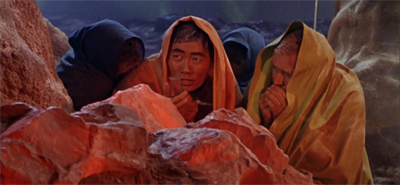
A cool reception…
The abuse that Whitney experienced is one of the most shameful moments in the history of the Star Trek franchise, and a demonstration of some of the problems the series had with sexism behind the scenes. Nobody was ever held accountable for it. Whitney herself was let go after her thirteen-episode contract elapsed. For a show about a bright an enlightened future, it seems that the sexual politics behind the scenes on Star Trek were regressive.
Sadly, these problems would continue into the early years of The Next Generation . After all, that show would lose two of its three female leads in the first year. Gates McFadden left because she had trouble working with a male producer . Patrick Stewart has explained that he spent a great deal of the first season protesting sexist scripts. You could make a compelling argument that Star Trek never got quite past its gender issues until Deep Space Nine introduced Kira.
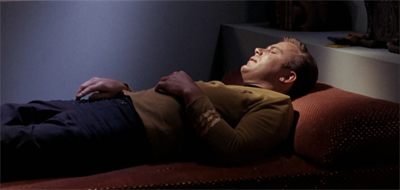
He’ll sleep it off…
Even outside of the context of Whitney’s departure from the series, the show’s final joke would seem to be misjudged. It sees Spock – who seems to have a bit of a weird fixation on evil! Kirk, read into that what you will – make a joke about evil! Kirk’s sexual appeal to Janice Rand. This is the same Janice Rand who was sexually assaulted by evil! Kirk in her quarters only a little while earlier. The scene is quite troublesome, especially because it seems like nobody realised that it really wasn’t an appropriate line to close on.
As Whitney herself notes in her memoirs, The Longest Trek :
At the end of The Enemy Within, there is a badly botched attempt at humor. In a poorly motivated and out of character moment, Mr. Spock needles me about my feelings toward the evil Kirk (who came to be called “the Imposter,” even though he was supposedly every bit as much a part of the “real” James T. Kirk as the good Kirk). There is almost a nasty leer on Spock’s face as he says to me, “The Imposter had some very interesting qualities, wouldn’t you say, yeoman?” My response was to ignore the jibe. I can’t imagine any more cruel and insensitive comment a man (or Vulcan) could make to a woman who has just been through a sexual assault! But then, some men really do think that women want to be raped. So the writer of the script (ostensibly Richard Matheson — although the line could have been added by Gene Roddenberry or an assistant scribe) gives us a leering Mr. Spock who suggests that Yeoman Rand enjoyed being raped and found the evil Kirk attractive! This scene is doubly ironic in view of how wonderfully caring and compassionate the real Leonard Nimoy was a few weeks later after the real Grace Lee Whitney was sexually assaulted and violated by The Executive.
Then again, the show was never especially thoughtful in its portrayal of Rand as a character. It’s just that The Enemy Within strikes closest to home in light of Whitney’s history with the programme.
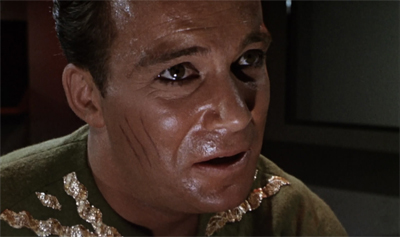
Some cheek…
Still, despite these awkward moments, The Enemy Within is still a damn fine piece of Star Trek . It’s admittedly got a goofy premise, but it is compelling and fascinating high-concept science-fiction, demonstrating the versatility of Star Trek as a show.
You might be interested in our other reviews from the first season of the classic Star Tre k :
- Supplemental: Vulcan’s Glory by D.C. Fontana
- Supplemental: Early Voyages #1 – Flesh of my Flesh
- Supplemental: Crew by John Byrne
- Where No Man Has Gone Before
- The Corbomite Manoeuvre
- Mudd’s Women
- The Enemy Within
- The Man Trap
- The Naked Time
- Supplemental: My Enemy, My Ally by Diane Duane
- Supplemental: Romulans: Pawns of War by John Byrne
- Supplemental: Errand of Vengeance: The Edge of the Sword by Kevin Ryan
- Dagger of the Mind
- The Conscience of a King
- The Galileo Seven
- Court Martial
- Supplemental: Early Voyages #12-15 – Futures
- Supplemental: Burning Dreams by Margaret Wander Bonanno
- Shore Leave
- The Squire of Gothos
- Supplemental: Requiem by Michael Jan Friedman & Kevin Ryan
- Supplemental: The Fantastic Four #108 – The Monstrous Mystery of the Nega-Man
- Tomorrow is Yesterday
- The Return of the Archon
- A Taste of Armageddon
- Supplemental: The Eugenics Wars: The Rise and Fall of Khan Noonien Singh, Volumes I & II by Greg Cox
- This Side of Paradise
- The Devil in the Dark
- Supplemental: Spock Must Die! by James Blish
- Supplemental: The Final Reflection by John M. Ford
- Supplemental: The City on the Edge of Forever by Harlan Ellison/Cordwainer Bird
- Supplemental: Crucible: McCoy – Provenance of Shadows by David R. George III
- Supplemental: Star Trek (Gold Key) #56 – No Time Like the Past
- Operation — Annihilate!
Share this:
Filed under: The Original Series | Tagged: Alice Eve , Benedict Cumberbatch , chris pine , City of the Edge of Forever , games , gene roddenberry , Grace Lee Whitney , Harlan Ellison , J. J. Abrams , james t. kirk , John Harrison , kirk , Leonard Nimoy , Ray Bradbury , richard matheson , science fiction , Shatner , spock , star trek , Star Trek Games , Star Trek: The Animated Series , star trek: the original series , StarTrek , Strange Case of Dr Jekyll and Mr Hyde , Television and Movies , Trekkie , video games , William Shatner , Zachary Quinto |
2 Responses
Reblogged this on Hopes & Dreams & Thoughts .
Thanks for the reblog!
Leave a comment Cancel reply
This site uses Akismet to reduce spam. Learn how your comment data is processed .
Recent Posts
- 373. Pirates of the Caribbean: The Curse of the Black Pearl (#225)
- 371. Poor Things (#246)
- 370. Dune: Part Two (#12)
- 369. Memento (#57)
- 368. Monty Python and the Holy Grail (#154)
Recently tweeted…
- "I Simply Am Not There": The Existential Horror of Eighties Excess in "American Psycho"...
- Star Trek: The Original Series (Reviews)
- Star Trek: Voyager (Reviews)
- The Ambiguous Ending of The Usual Suspects...
Available at…

Blogs Well Worth Your Time
- 1001 Must See Films
- Andrew at the Movies
- Anomalous Material
- Cut the Crap Movie Reviews
- Encore Entertainment
- Fandango Groovers
- FlixChatter
- Four of Them
- It Rains… You get Wet…
- Jameson Cult Film Blog
- Jar Watches Films
- Let's Go To The Movies
- M. Carter at the Movies
- Marshall and the Movies
- Movie News First
- Musings from a Man Lost in La Mancha
- Never Mind Pop Film
- Paragraph Film Reviews
- Roger Ebert's Journal
- Ross v. Ross
- Scannain.com
- Screenwriter (Donald Clarke, Irish Times)
- Strange Culture
- The Film Cynics
- The Pompous Film Snob
- The Projection Booth
- Things That Don't Suck
- Too Busy Thinking About My Comics
- Undy a Hundy
Film Nerd Resources
- CinemaBlend (News)
- Internet Movie Database
- Rope of Silicon
- The Guardian Film Blog
- James Berardinelli
- Roger Ebert
Email Subscription
Enter your email address to follow this blog and receive notifications of new posts by email.
Email Address:
Sign me up!
Blog at WordPress.com. WP Designer.
- Already have a WordPress.com account? Log in now.
- Subscribe Subscribed
- Copy shortlink
- Report this content
- View post in Reader
- Manage subscriptions
- Collapse this bar
Den of Geek
Star Trek Just Addressed One of Deep Space Nine’s Biggest Unanswered Questions
The Star Trek: Discovery episode "Mirrors" includes a HUGE reveal about the Breen, an odd alien species from Deep Space Nine.

- Share on Facebook (opens in a new tab)
- Share on Twitter (opens in a new tab)
- Share on Linkedin (opens in a new tab)
- Share on email (opens in a new tab)
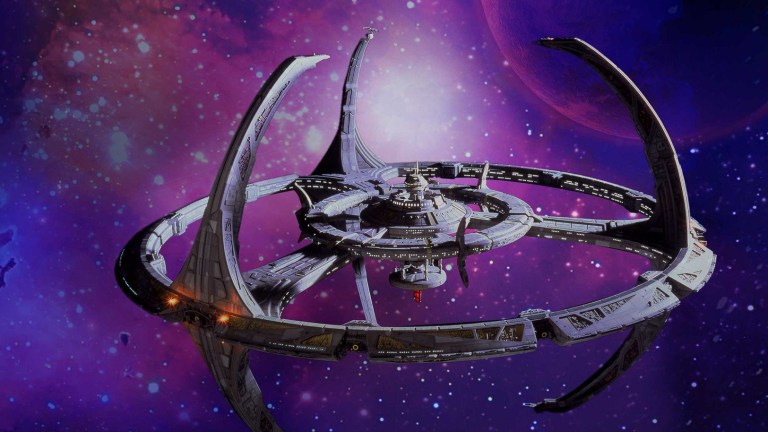
This Star Trek: Discovery article contains spoilers.
“I wonder what the Breen look like under those helmets?” asks Ezri Dax in the Deep Space Nine season seven episode “‘Till Death Do Us Part.” That’s a strange question, given that Ezri and Worf had been captured by the Breen and interrogated for some time. But despite their close and uncomfortable contact with the hostile alien species, neither hostage learned much about them.
“They say no one has ever seen one and lived to speak of it,” Worf answers.
Ezri continues in her usual lighthearted manner. “Maybe they’re all furry. It’s supposed to be very cold on Breen.”
Ad – content continues below
“One thing is certain.”
“They’re horrible cooks?”
“They are dangerous,” responds Worf, with even greater gravity than the Klingon usually assumes. “They do not tolerate incursions into their space. During the Second Empire, Chancellor Mow’ga sent a fleet of Klingon ships to conquer their homeworld, and they were never heard from again.”
Until today, that bit of dialogue encapsulated everything that Trekkies knew about the Breen. First mentioned in The Next Generation, the Breen appeared most prominently in the final season of Deep Space Nine , in which the Breen presented a threat that undid whatever gains the Federation had made in the Dominion War.
When the Dominion first entered the Alpha Quadrant through a wormhole from the Gamma Quadrant, they threatened to immediately overwhelm the Federation. As a result, the Federation had to align with longtime antagonists the Klingon Empire and the Romulan Star Empire. That confederation was more than a match for the Dominion/Cardassian alliance, but then the Dominion upped its hand by enlisting the terrifying Breen. It would take a miracle for the Alpha Quadrant forces to win. Fortunately, the Federation had a miracle on its side in the form of the Prophets (and the morally flexible Section 31 ) and won the war.
The Breen rarely appeared after Deep Space Nine concluded, and it’s easy to see why. They felt like they came from another universe, even moreso than the alien oddities that often appeared on Star Trek . With their monocular helmets and gravelly, indistinguishable voices, they felt like something out of Star Wars — specifically, they felt like riffs on Princess Leia’s bounty hunter disguise at the start of Return of the Jedi . Although they get a couple of nods in Voyager and, of course, Lower Decks , the Breen were largely relegated to a handful of non-canon novels.
That is, until the Star Trek: Discovery season five episode “ Mirrors .” In that episode, we finally learn that L’ak, a courier who has been chasing past Discovery in a search for Progenitor tech with his partner Moll, is a Breen who doesn’t wear helmet that hides his face, showing us for the first time what the species actually looks like under the armor. That’s a surprise because L’ak appeared to be just a regular green-skinned alien, a little lizard-esque in appearance, almost like a Reptilian Xindi from Enterprise .
Get the best of Den of Geek delivered right to your inbox!
In fact, “Mirrors” does a lot more than just show us the face of the Breen. We also learn more about their culture, getting a sense of why they refuse to use a Universal Translator in conversation with other races and of their political system. In a move that recalls another Star Wars property, The Mandalorian , the Breen consider their helmets their true faces, and in fact have a transparent look when they remove that helmet.
But as L’ak makes clear, the Breen have the capacity to change, something hinted by the warmth and softness performer Elias Toufexis brings to his imposing character. Not only has L’ak made his skin non-translucent, but he’s adopted Federation Standard (aka English) and moved beyond his hierarchical culture.
Those changes are a good thing, because the Breen have always created problems for Star Trek canon. As many fans have noted, although Worf insisted that no one had seen the Breen under their costumes, Kira and others stole Breen uniforms to move behind enemy lines at one point on the series. They must have gotten a glimpse of the Breen then, right?
For Ronald D. Moore , one of the key creatives during the ’90s Star Trek era, that’s not necessarily the case. “There’s nothing in those helmets. I don’t think there’s a guy in there, which is something we never got around to saying,” Moore said in the Star Trek: Deep Space Nine Companion . “Or maybe there’s a little slug, some tiny little creature in there. I never wanted them to be humanoid in any way.”
“Mirrors” goes against Moore’s wishes then, but that shouldn’t be too much of a surprise. Discovery started its life by radically altering the Klingons. Looks like it will be ending its life by radically altering the Breen. But this time, it’s for the better.
Star Trek: Discovery is streaming now on Paramount+.

Joe George | @jageorgeii
Joe George’s writing has appeared at Slate, Polygon, Tor.com, and elsewhere!
- Cast & crew
- User reviews
The Enemy Within
- Episode aired Oct 6, 1966

A transporter malfunction splits Captain Kirk into two halves: one meek and indecisive, the other violent and ill tempered. The remaining crew members stranded on the planet cannot be beamed... Read all A transporter malfunction splits Captain Kirk into two halves: one meek and indecisive, the other violent and ill tempered. The remaining crew members stranded on the planet cannot be beamed up to the ship until a problem is fixed. A transporter malfunction splits Captain Kirk into two halves: one meek and indecisive, the other violent and ill tempered. The remaining crew members stranded on the planet cannot be beamed up to the ship until a problem is fixed.
- Richard Matheson
- Gene Roddenberry
- William Shatner
- Leonard Nimoy
- DeForest Kelley
- 46 User reviews
- 14 Critic reviews

- Captain James Tiberius 'Jim' Kirk

- Mister Spock

- Yeoman Rand

- (as Edward Madden)

- Lieutenant Nyota Uhura
- (uncredited)

- All cast & crew
- Production, box office & more at IMDbPro
Did you know
- Trivia The original script called for Spock to karate chop Kirk to subdue him. Leonard Nimoy felt that this would be an uncharacteristically violent act for a peace-loving species like the Vulcans so he came up with a pincer-like grasp on the neck that has since become known as the Vulcan Nerve Pinch and become one of the character's most famous gimmicks.
- Goofs During the showdown between Good Kirk and Evil Kirk on the bridge, Evil Kirk's scratch marks are suddenly shown on the right cheek instead of the left as they had been throughout the episode.
Lt. Cmdr. Leonard 'Bones' McCoy, M.D. : He's dead, Jim.
- Alternate versions Special Enhanced version Digitally Remastered with new exterior shots and remade opening theme song
- Connections Featured in Star Trek Logs: An MTV Big Picture Special Edition (1991)
- Soundtracks Theme From Star Trek Written by and credited to Alexander Courage
User reviews 46
- Mar 14, 2021
- October 6, 1966 (United States)
- United States
- Official Facebook
- Desilu Studios - 9336 W. Washington Blvd., Culver City, California, USA
- Desilu Productions
- Norway Corporation
- See more company credits at IMDbPro
Technical specs
- Runtime 50 minutes
Related news
Contribute to this page.
- IMDb Answers: Help fill gaps in our data
- Learn more about contributing
More to explore

Recently viewed

Behind The Scenes: The Making of Two Captain Kirks in “The Enemy Within”
I n the world of the Starship Enterprise, there seldom were television moments as intriguing as seeing Captain Kirk face his doppelgänger. The classic “Star Trek” episode “The Enemy Within” showcases this scenario and the seamless interaction between the two Kirks is a testament to the skilled storytelling and production techniques of the show. Renowned science fiction author Richard Matheson penned this memorable episode and found himself in alignment with creator Gene Roddenberry, making for a smooth creative process. An anecdote recounts a harmonious meeting between the two:
“Matheson was in sync with ‘Star Trek’s’ concept from the beginning, and had a similar experience previously on ‘The Twilight Zone.’ This made discussions about the episode’s structure relatively straightforward, with only minor disagreements.” – Black
Matheson’s previous work included the iconic “Twilight Zone” episode “Nightmare at 20,000 Feet,” starring none other than William Shatner himself.
Challenges did arise during the shooting of “The Enemy Within,” particularly in scenes that required both Kirks to interact physically. Director Leo Penn explained that a photo double for Shatner was employed and creative camera work was essential:
“The process of filming the scenes with both Kirks required inventive shooting techniques and meticulous coordination, especially when physical interactions were involved, necessitating the use of a photo double.” – Penn
While the final product was convincing, keen-eyed viewers noted that the photo double’s hair wasn’t an exact match for Shatner’s distinct look.
FAQs About “The Enemy Within” Episode
- Q: Who wrote the “Star Trek” episode “The Enemy Within”?
- A: The episode was written by Richard Matheson, an acclaimed sci-fi author.
- Q: What was one of the biggest challenges in filming scenes with both Kirks?
- A: The biggest challenge was filming scenes where the two Kirks had to physically interact, which required a photo double and creative camera work.
- Q: Did Gene Roddenberry have any issues with the script for “The Enemy Within”?
- A: No significant issues were mentioned. Roddenberry and Matheson reportedly had a productive meeting with only minor points of contention regarding the story’s direction.
- Q: Was “The Enemy Within” the first time William Shatner worked with Richard Matheson?
- A: No, they had previously collaborated on the “Twilight Zone” episode “Nightmare at 20,000 Feet.”
In conclusion, the “Star Trek” episode “The Enemy Within” is an exemplar of classic sci-fi storytelling and innovative television production. Thanks to the synergy between writer Richard Matheson and series creator Gene Roddenberry, as well as director Leo Penn’s resourceful filming techniques, audiences were treated to a compelling narrative that stood the test of time. It’s these behind-the-scenes efforts that helped turn “Star Trek” into the legendary franchise it is today. Despite minor hiccups, such as the slight disparity in the photo double’s hairstyle, the episode remains a standout in “Star Trek” lore and a favorite among fans.

Screen Rant
3 ways star trek: discovery showed how dangerous temporal wars were.
Introduced in Star Trek: Enterprise, the Temporal Wars took place across Federation history. Here's what Discovery has revealed about the conflict.
- The Temporal Wars revealed in Star Trek: Discovery had lasting impacts on key events in the Star Trek universe.
- Time bugs like the Krenim chronophage from Voyager can trap starships in loops, impacting future conflicts.
- The Guardian of Forever was a key weapon in the Temporal Wars, with implications for characters like Georgiou.
Star Trek: Discovery has demonstrated how dangerous the Temporal Wars were, by revealing three things about its lasting impact on the Star Trek universe. Introduced in Star Trek: Enterprise , the Temporal Wars were a major conflict between various powers, including the Federation, that took place across the entire Star Trek timeline . In Star Trek: Discovery season 5, episode 4, "Face the Strange", written by Sean Cochran and directed by Lee Rose, Captain Michael Burnham (Sonequa Martin-Green) and the crew of the USS Discovery become victims of a Krenim chronophage, a deadly weapon left over from the Temporal Wars .
The " time bug " from Star Trek: Discovery season 5, episode 4 isn't the first time that the modern franchise has explored the ramifications of the Temporal Wars. In Star Trek: Strange New Worlds season 2, episode 3, "Tomorrow, and Tomorrow, and Tomorrow", Lt. La'an Noonien-Singh (Christina Chong) faced off against a Romulan time agent, Sera (Adelaide Kane). During their confrontation, Sera revealed that the Temporal Wars have changed the dates of key Star Trek events like the Eugenics Wars and World War 3 . Set roughly 200 years after the Temporal Wars ended, Star Trek: Discovery has revealed even more information about the dangers of this space-time conflict.
Star Trek: Discovery Reveals A Voyager Enemy Played A Big Role In The Temporal Wars
Crossing over between star trek universes is fatal.
In Star Trek: Discovery season 3, episode 9, "Terra Firma, Part 1", it was revealed that time soldiers fighting in the Temporal Wars had to contend with a horrific metaphysical affliction. When former Terran Emperor Philippa Georgiou (Michelle Yeoh) began breaking down on a molecular level, Dr. Hugh Culber (Wilson Cruz) sought answers. Federation scientist Dr. Kovich (David Cronenberg) revealed that Georgiou wasn't the first person to experience this condition. During the Temporal Wars, a time soldier called Yorg from the Kelvin Timeline became trapped in the prime Star Trek universe after traveling forward from the 24th century .
Although it's just a hologram, Yor is currently the only character from the Kelvin Timeline's 24th century that's been seen on screen.
Yor and Georgiou were breaking down because the molecules in their body were fighting to return to the correct universe and time period . The only known cure was to return Yor to his own universe, but this was prohibited by the Interdimensional Displacement Restriction, a key tenet of the Temporal Accords. Starfleet fought the wars to uphold the Federation's Temporal Accords, and so refused to break them by returning Yor, and Georgiou to their own universes. Instead, other alternatives had to be pursued to cure Georgiou of her condition, so that she wasn't euthanized like the tragic Yor.
Temporal Wars Wanted To Use The Guardian Of Forever As A Weapon
To cure Georgiou of her condition, she and Burnham had to bargain with the Guardian of Forever, first seen in Star Trek: The Original Series . In "City on the Edge of Forever", Captain James T. KIrk (William Shatner) discovers the Guardian on a planet where the timelines of the Milky Way galaxy converge. The Guardian was a sentient time portal, constructed by an unknown alien race, but described itself as neither machine nor being . In Star Trek: The Animated Series season 1, episode 2, "Yesteryear", the Guardian allows Federation scientists to use it to observe their own history.
Scotty actor James Doohan voiced the Guardian of Forever in Star Trek: The Animated Series ' "Yesteryear"
By the 32nd century, however, the Guardian of Forever was forced to relocate due to the Temporal Wars. Given that it allowed access to the entire course of history, the various powers involved in the Temporal Wars wanted to weaponize the Guardian's abilities against their enemies. The Guardian therefore transported itself to the planet Dannus V, where it remained in hiding until it was discovered by Burnham and Georgiou in Star Trek: Discovery season 3. Now able to assume the humanoid form of Carl (Paul Guilfoyle), the Guardian of Forever was more reluctant to help visitors, forcing Georgiou to prove herself to him by returning to the Mirror Universe to show how much she'd changed .
Star Trek: Voyager’s Krenim Time Bugs Can Trap Starships In Loops
Star Trek: Discovery season 5, episode 4, "Face the Strange" confirmed that the Krenim Imperium, introduced in Star Trek: Voyager, played a role in the Temporal Wars. Moll (Eve Harlow) and L'ak (Elias Toufexis) planted a Krenim chronophage aboard the USS Discovery by pinning it to the uniform of Ensign Adira Tal (Blu del Barrio). Once the chronophage was aboard, it burrowed itself into Discovery's engineering and trapped the ship in a random cycle of their own past and future . While the USS Discovery was trapped in a time loop, Moll and L'ak could get a head start on the next clue in the hunt for the Progenitors' technology.
Commander Rayner (Callum Keith Rennie) confirmed that this weapon was left over from the Temporal Wars, where it had been used against various enemy ships. Unable to break out of the loop, a starship could find itself in a completely changed battlefield once the time bug ran out of juice. In the case of the USS Discovery, their time bug nearly led to an inevitable conflict with Star Trek: DS9 's Breen . It's a typically tricksy time weapon from the masters of temporal technology, the Krenim, who once built a weapon that could remove entire species from the space-time continuum.
Captain Kathryn Janeway (Kate Mulgrew) destroyed the Krenim time ship, negating the timeline where it was built, however it's clear that this didn't stop the species from experimenting with temporal weaponry.
The confirmation that Star Trek: Voyager 's Krenim Imperium were involved in the Temporal Wars further heightens the stakes of a conflict that is technically still ongoing. While the Temporal Wars may be over in Star Trek: Discovery 's 32nd century, there are still battles taking place elsewhere in the Star Trek timeline. This means that starship crews from Star Trek: Strange New Worlds to Star Trek: Lower Decks could find themselves embroiled in the devastating temporal conflict first started in Star Trek: Enterprise .
Star Trek: Discovery streams Thursdays on Paramount+.
Star Trek: Discovery
*Availability in US
Not available
Star Trek: Discovery is an entry in the legendary Sci-Fi franchise, set ten years before the original Star Trek series events. The show centers around Commander Michael Burnham, assigned to the USS Discovery, where the crew attempts to prevent a Klingon war while traveling through the vast reaches of space.
Star Trek: Enterprise
Star Trek: Enterprise acts as a prequel to Star Trek: The Original Series, detailing the voyages of the original crew of the Starship Enterprise in the 22nd century, a hundred years before Captain Kirk commanded the ship. Enterprise was the sixth series in the Star Trek franchise overall, and the final series before a twelve-year hiatus until the premiere of Star Trek: Discovery in 2017. The series stars Scott Bakula as Captain Jonathan Archer, with an ensemble cast that includes John Billingsley, Jolene Blalock, Dominic Keating, Anthony Montgomery, Linda Park, and Connor Trinneer.
Star Trek: The Original Series
Star Trek: The Original Series follows the exploits of the crew of the USS Enterprise. On a five-year mission to explore uncharted space, Captain James T. Kirk (William Shatner) must trust his crew - Spock (Leonard Nimoy), Dr. Leonard "Bones" McCoy (Forest DeKelley), Montgomery "Scotty" Scott (James Doohan), Uhura (Nichelle Nichols), Chekov (Walter Koenig) and Sulu (George Takei) - with his life. Facing previously undiscovered life forms and civilizations and representing humanity among the stars on behalf of Starfleet and the United Federation of Planets, the Enterprise regularly comes up against impossible odds and diplomatic dilemmas.
Star Trek: Voyager
The fifth entry in the Star Trek franchise, Star Trek: Voyager, is a sci-fi series that sees the crew of the USS Voyager on a long journey back to their home after finding themselves stranded at the far ends of the Milky Way Galaxy. Led by Captain Kathryn Janeway, the series follows the crew as they embark through truly uncharted areas of space, with new species, friends, foes, and mysteries to solve as they wrestle with the politics of a crew in a situation they've never faced before.

COMMENTS
"Balance of Terror" is the fourteenth episode of the first season of the American science fiction television series Star Trek. Written by Paul Schneider and directed by Vincent McEveety, it first aired on December 15, 1966.. In the episode, the USS Enterprise battles a Romulan ship after investigating an unidentified assailant who methodically destroys the Federation's outposts at the Neutral ...
Balance of Terror: Directed by Vincent McEveety. With William Shatner, Leonard Nimoy, Mark Lenard, Paul Comi. The Enterprise must decide on its response when a Romulan ship makes a destructively hostile armed probe of Federation territory.
The plot of this episode is based on the 1957 film The Enemy Below, with the Enterprise taking the part of the American destroyer and the Bird-of-Prey with its cloaking device taking the part of the submarine. (The Star Trek Compendium 4th ed., p.
"Balance of Terror" was the 14th episode of season one. Writer Paul Schneider successfully evoked war stories and submarine dramas, a la the film The Enemy Below, in his teleplay.As the Star Trek Compendium puts it, think of the Enterprise as a "surface vessel" and the invisible Romulan ship as a "submarine" and you've got the basic concept.; Schneider also wrote the TOS episode "The Squire of ...
The Enemy Below is a 1957 American DeLuxe Color war film in CinemaScope about a battle between an American destroyer escort and a German U-boat during World War II.It stars Robert Mitchum and Curt Jürgens as the American and German commanding officers, respectively. Produced and directed by Dick Powell, the film was based on the 1956 novel of the same name by Denys Rayner, a British naval ...
As Kirk matches the Romulan Commander move for move, he's dealt the ultimate compliment by his adversary - "He's a sorcerer, that one". Knowledgeable viewers have mentioned 1957's "The Enemy Below" as part inspiration for this Star Trek classic, and the plot might have been given an even greater psychological thrust in 1981's "Das Boot".
As David writes, The Enemy Below was yet another influence on this episode. And, as he also says, The Enemy Below is a good World War II sub movie that's worth seeking out. For me, "Balance of Terror" is in my top ten in terms of episodes of the original Star Trek—I'm just not sure what the other nine are right now….
The Enemy Below (1957) cast and crew credits, including actors, actresses, directors, writers and more. Menu. Movies. Release Calendar Top 250 Movies Most Popular Movies Browse Movies by Genre Top Box Office Showtimes & Tickets Movie News India Movie Spotlight. TV Shows.
Of course, all 'new' ideas in storytelling have their roots in earlier works. "The Enemy Below" was hardly the first movie that Star Trek drew inspiration from ("The Galileo Seven" is also a remake of 1965's "Flight of the Phoenix," for example).But what makes "Balance of Terror" still work, despite the obvious 'homages', are those uniquely Star Trek elements; a ...
The Enemy Below is the story of a battle between an American Destroyer captain and a German U-Boat commander during World War II. It stars Robert Mitchum as ...
Includes all episodes of Star Trek: The Original Series, The Animated Series, The Next Generation, Deep Space Nine, Voyager, Enterprise, Discovery, Picard, Lower Decks, Prodigy, and Strange New Worlds. ... Thanks for posting the link to "The Enemy Below" SouthofNorth -- it is a terrific movie and clearly BoT borrows a great deal from it, but I ...
Personally, I think "Balance of Terror" was the second-best episode for Season 1. "A Quality of Mercy" is absolute best for Strange New Worlds so far and The Enemy Below won an Oscar. It's amazing how much good content came from just one story. Unfortunately, can't find it included on anything like Netflix or Hulu, but it is on YouTube.
Conclusion - The Enemy Below (1957) First things first. This movie is the same story as "Star Trek" 1966-1969, Season 1, Episode 14, "Balance of Terror," aired in December 1966. In "Balance of Terror," a cloak-equipped Romulan ship crosses the Neutral Zone.
The Enemy Below is set entirely at sea and it was shot largely on location, with the warm Pacific waters off the Hawaiian Islands standing in for the South Atlantic. The American destroyer escort U.S.S. Whitehurst, a World War II survivor stationed at Pearl Harbor, played the fictional U.S.S. Haynes. ... The film also inspired the 1966 Star ...
The Crossword Solver found 30 answers to "star trek enemy with the", 4 letters crossword clue. The Crossword Solver finds answers to classic crosswords and cryptic crossword puzzles. Enter the length or pattern for better results. Click the answer to find similar crossword clues . Enter a Crossword Clue. A clue is required.
A cat version of "The Enemy Within" was featured in Jenny Parks' 2017 book Star Trek Cats. Preview [] The preview contains a Captain's Log recorded solely for the preview, but based on one from the finished episode: "Captain's log, stardate 1672.9. Due to the malfunction of the ship's transporter, an unexplained duplicate of myself exists."
The plot of this episode is based on The Enemy Below (1957), with the Enterprise taking the part of the American destroyer and the Bird-of-Prey with its cloaking device taking the part of the submarine.This episode was also partly inspired by another World War II Submarine Drama, Run Silent Run Deep (1958), which was directed by Robert Wise, who would later direct Star Trek: The Motion Picture ...
The episode is Star Trek's answer to the 1957 film The Enemy Below, an adaptation of the 1956 novel of the same name. Both were based on the Battle of the Atlantic, the longest continuous campaign ...
My Star Trek Reviews Jeremy A Perron's multiple year mission to complete an interesting and witty review for every Star Trek series, every movie, and maybe branch out into my novel collection. Spoilers!
The Enemy Below is a 1957 war film directed and produced by Dick Powell, which shows the battle between the captain of an American destroyer escort and the commander of a German U-boat during World War II.It stars Robert Mitchum and Curd Jürgens. The film was based on a novel by Denys Rayner, a British naval officer involved in anti-submarine warfare throughout the Battle of the Atlantic.
Pike Moreau reduces the enemy's ability to penetrate your defence. Picard Beverly improves your own defence. therefore, the following factors need to be considert 2.1 Strength of the Hostiles. The stronger your enemy is, the stronger Moreau becomes 2.2 Level of your officers.
In a way, The Enemy Within is effectively an update of The Strange Case of Dr. Jekyll and Mr. Hyde.Transporter proves itself remarkably unreliable for only the first time in Star Trek history, somehow splitting Kirk into two halves. One half embodies all of Kirk's best qualities, and the other half contains all his negative attributes.
The Star Trek: Discovery episode "Mirrors" includes a HUGE reveal about the Breen, an odd alien species from Deep Space Nine. ... Ad - content continues below. That is, until the Star Trek ...
The Enemy Within: Directed by Leo Penn. With William Shatner, Leonard Nimoy, DeForest Kelley, Grace Lee Whitney. A transporter malfunction splits Captain Kirk into two halves: one meek and indecisive, the other violent and ill tempered. The remaining crew members stranded on the planet cannot be beamed up to the ship until a problem is fixed.
In conclusion, the "Star Trek" episode "The Enemy Within" is an exemplar of classic sci-fi storytelling and innovative television production. Thanks to the synergy between writer Richard ...
In Star Trek: Discovery season 3, episode 9, "Terra Firma, Part 1", it was revealed that time soldiers fighting in the Temporal Wars had to contend with a horrific metaphysical affliction.When former Terran Emperor Philippa Georgiou (Michelle Yeoh) began breaking down on a molecular level, Dr. Hugh Culber (Wilson Cruz) sought answers. Federation scientist Dr. Kovich (David Cronenberg) revealed ...